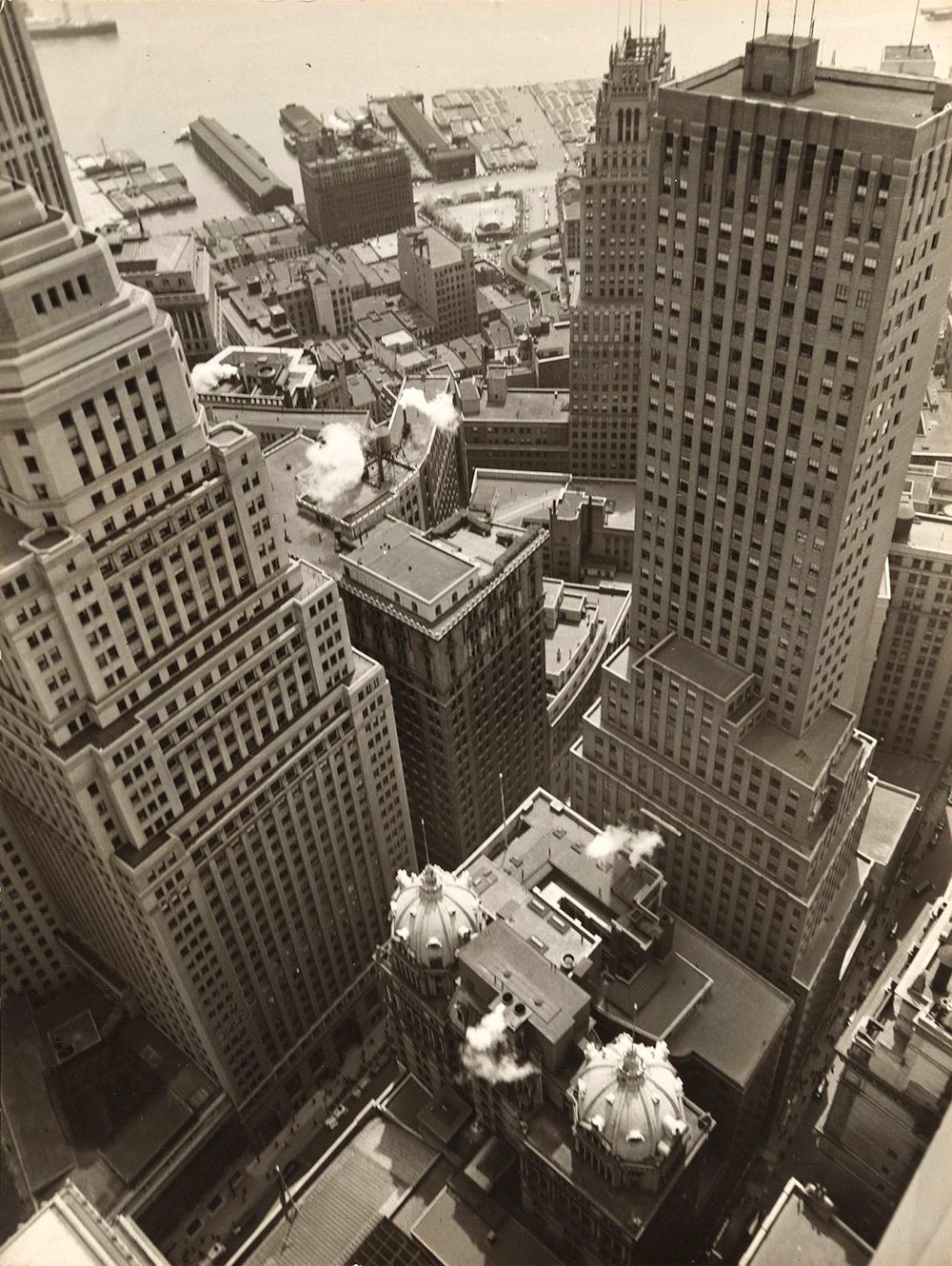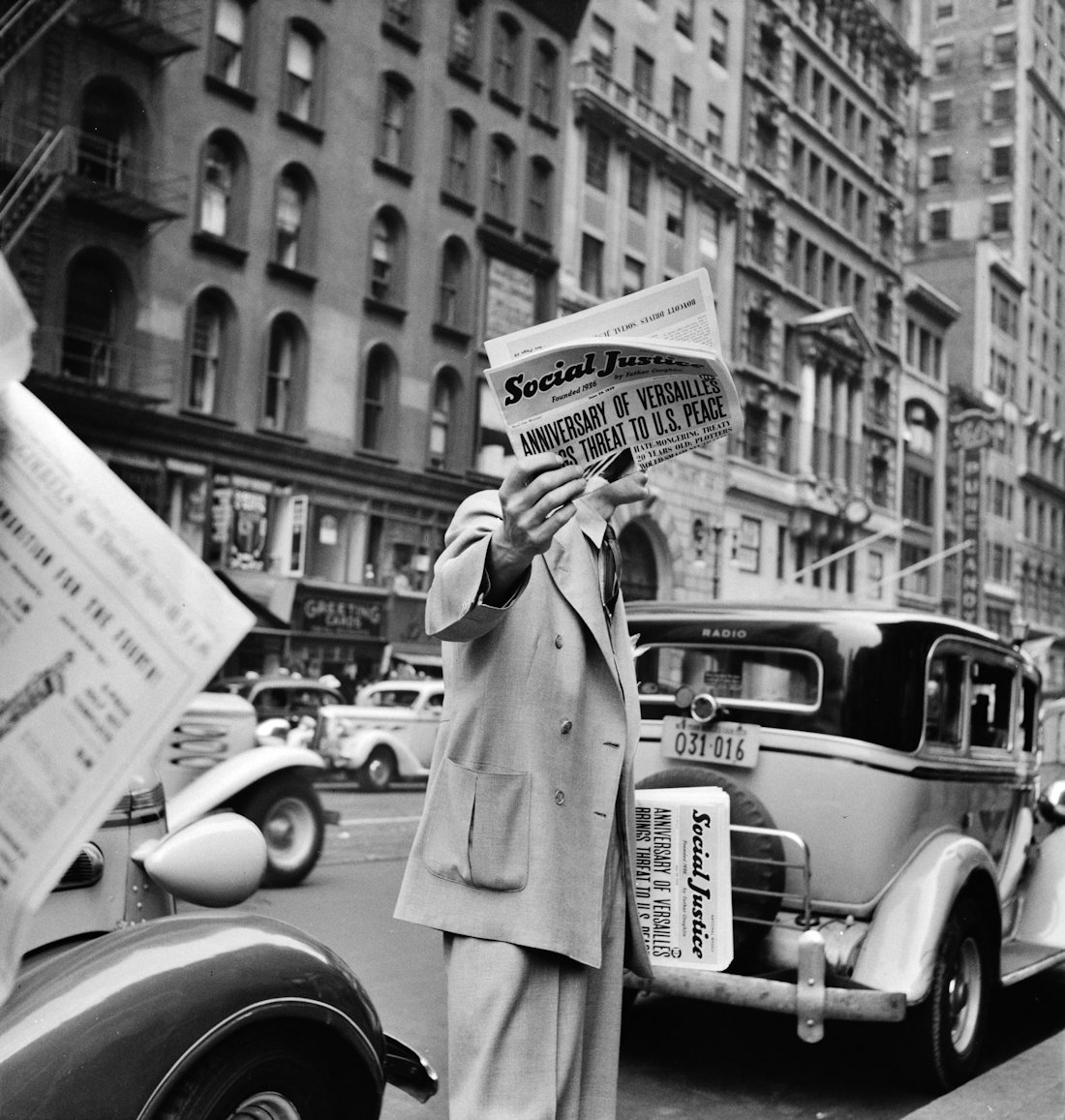New York City in the 1930’s – Vintage Photos
This collection of photos of New York City in the 1930’s shows a city of contradictions: small mom-and-pop shops and everyday people set against a backdrop of towering skyscrapers and big business. It may have been the middle of the Great Depression, but life in the Big Apple went on.
It was during this decade that many of the city’s most iconic skyscrapers were erected: the Empire State Building, the Chrysler Building, Rockefeller Center, among others. Many of these buildings that help define New York are pictured here, alongside street scenes and the people who kept the city moving along.
These glimpses into New York life in the 1930’s are the work of various WPA photographers of the time, working as part of the Federal Arts Project, a New Deal program designed to employ artists during the nation’s darkest days.
New York City street scene from June 1936
While most of her focus during the 1930’s was on the plight of rural Americans struggling to make ends meet during the Great Depression, photographer Dorothea Lange also managed to capture some images of people on the streets of New York City, as in this photo of a lone picketer among the hustle and bustle of the city streets.
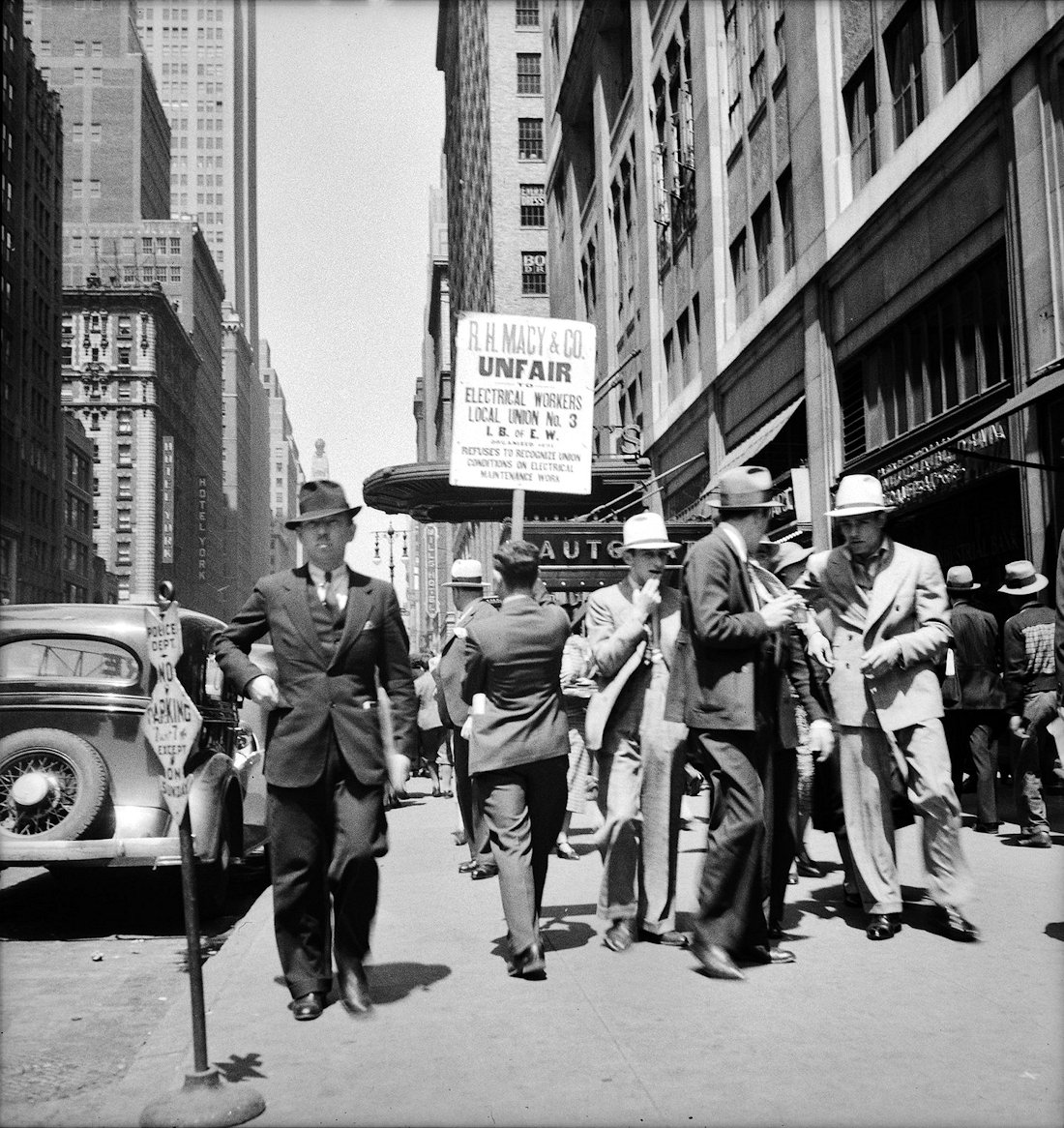
Hawking newspapers on the street corner in 1939
The Social Justice newspaper, founded by Father Coughlin, is sold on important street corners and intersections in New York City in 1939. The controversial periodical was known for printing anti-semitic rhetoric, and once America entered into World War II its mailing permit was revoked. It ceased publication in 1942.
A rainy evening in New York City
When the sun goes down in New York, the city comes to life with a million sparkling lights. Look closely at this nighttime cityscape and you can just make out the shimmering sidewalks and streets where rain has washed away the grime. This view looking north from University Place in 1939 is captured perfectly by FSA photographer Marion Post Wolcott.
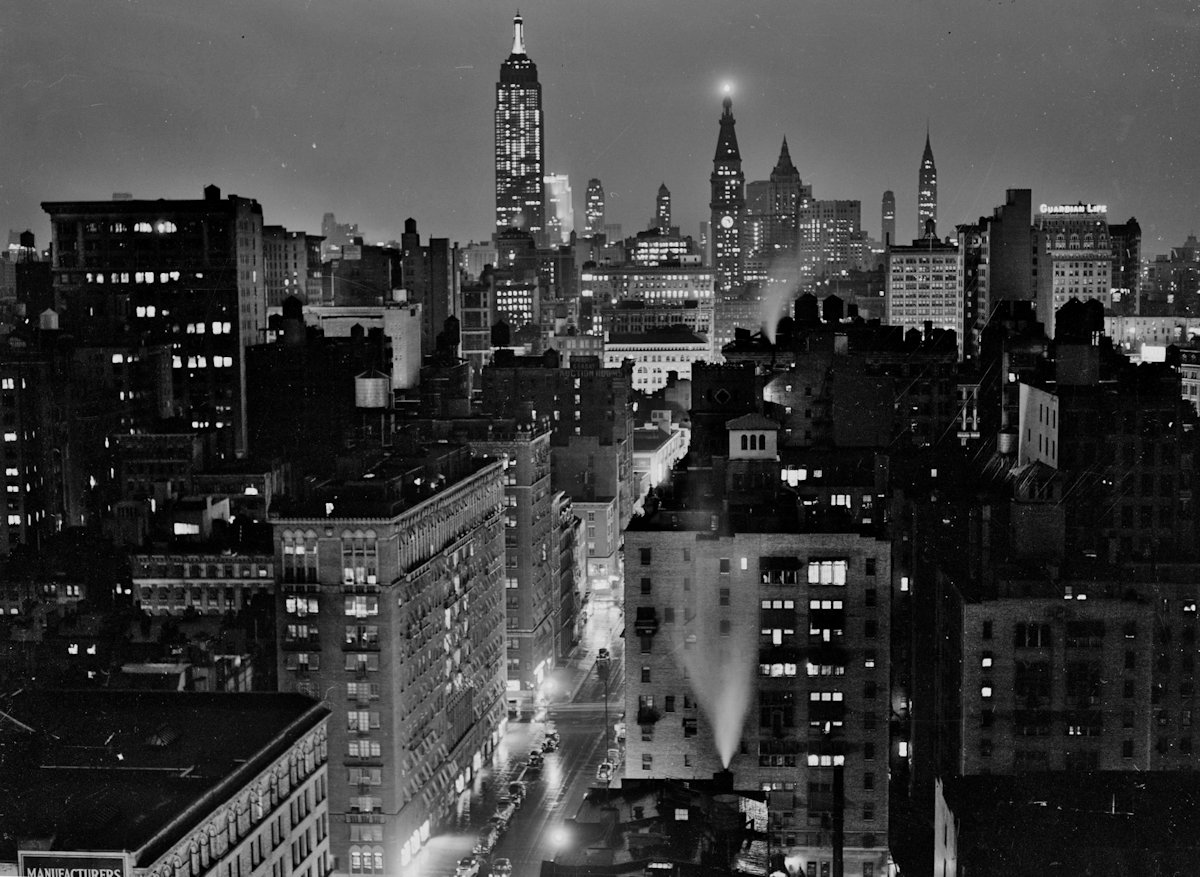
A rainy evening in New York City looking west
Another beautiful nighttime cityscape from Marion Post Wolcott, this view from University Place in Lower Manhattan looks west toward the Hudson River. One skyscraper dominates the foreground and seems to dwarf the rest of the city’s buildings.
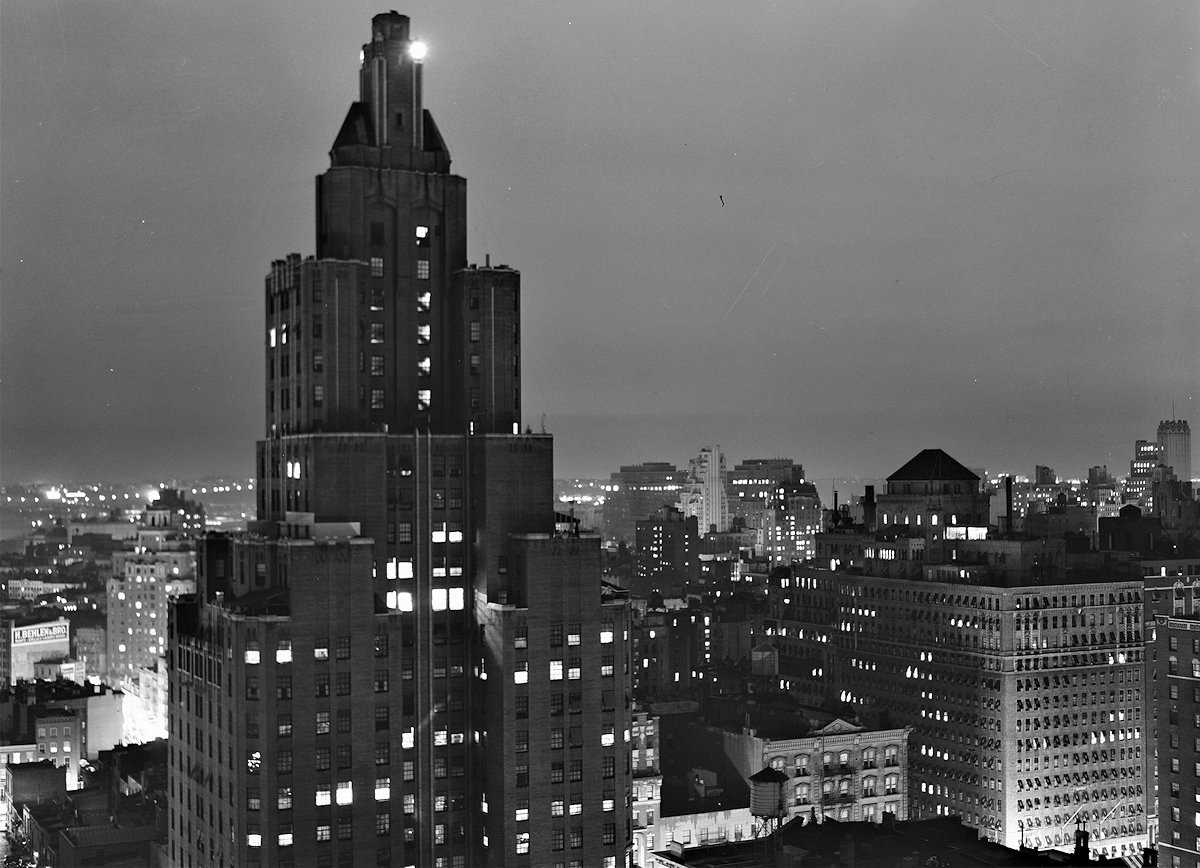
View of River House from across East River
Looking from across the East River, the palatial “River House” (at right) features Art Deco architecture, a central tower topped by a crown, and two massive fifteen-story wings enhanced with loggias, terraces, and balconies. This photo from 1931 also shows the Chrysler Building in the distance.
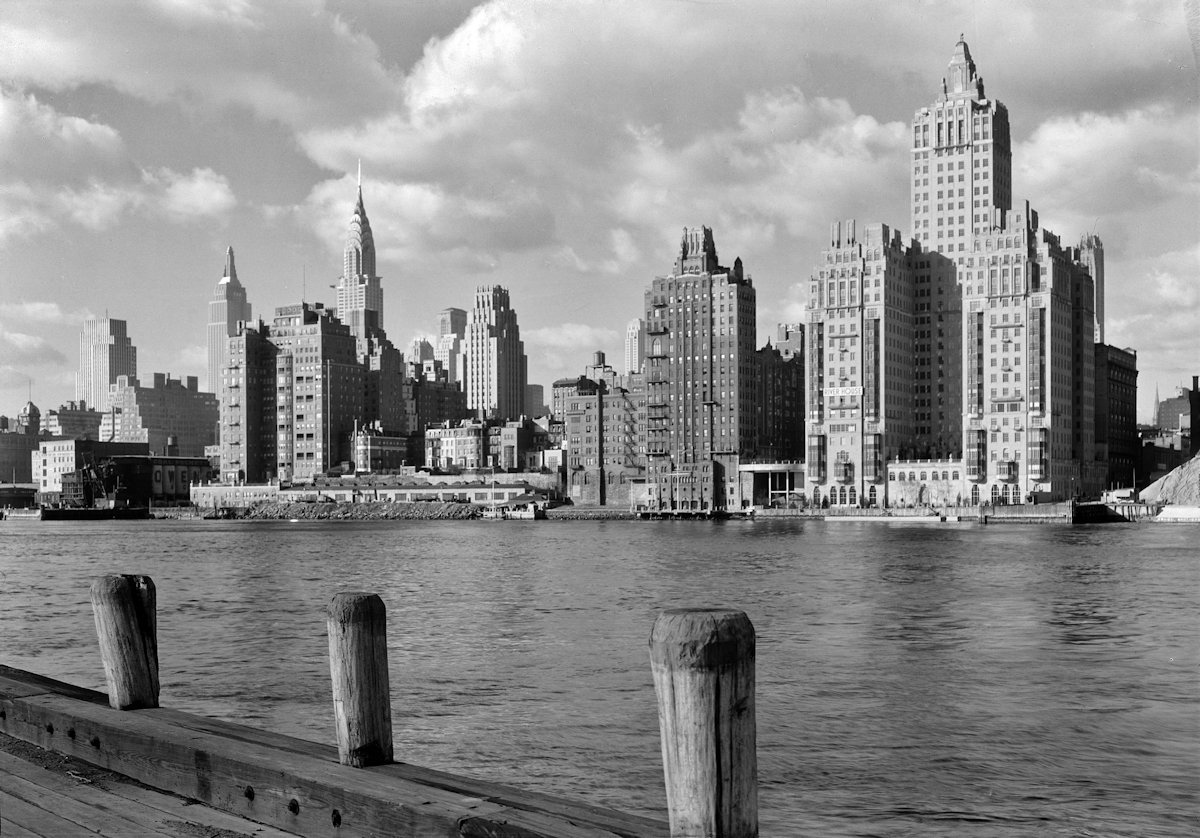
View from Empire State Building to Chrysler Building
In 1932, the Empire State Building was the tallest building in New York City, and this view just a year after its opening shows just how much it towers over the city. The Chrysler Building takes center stage in this shot, with the Queensboro Bridge crossing the East River in the distance.
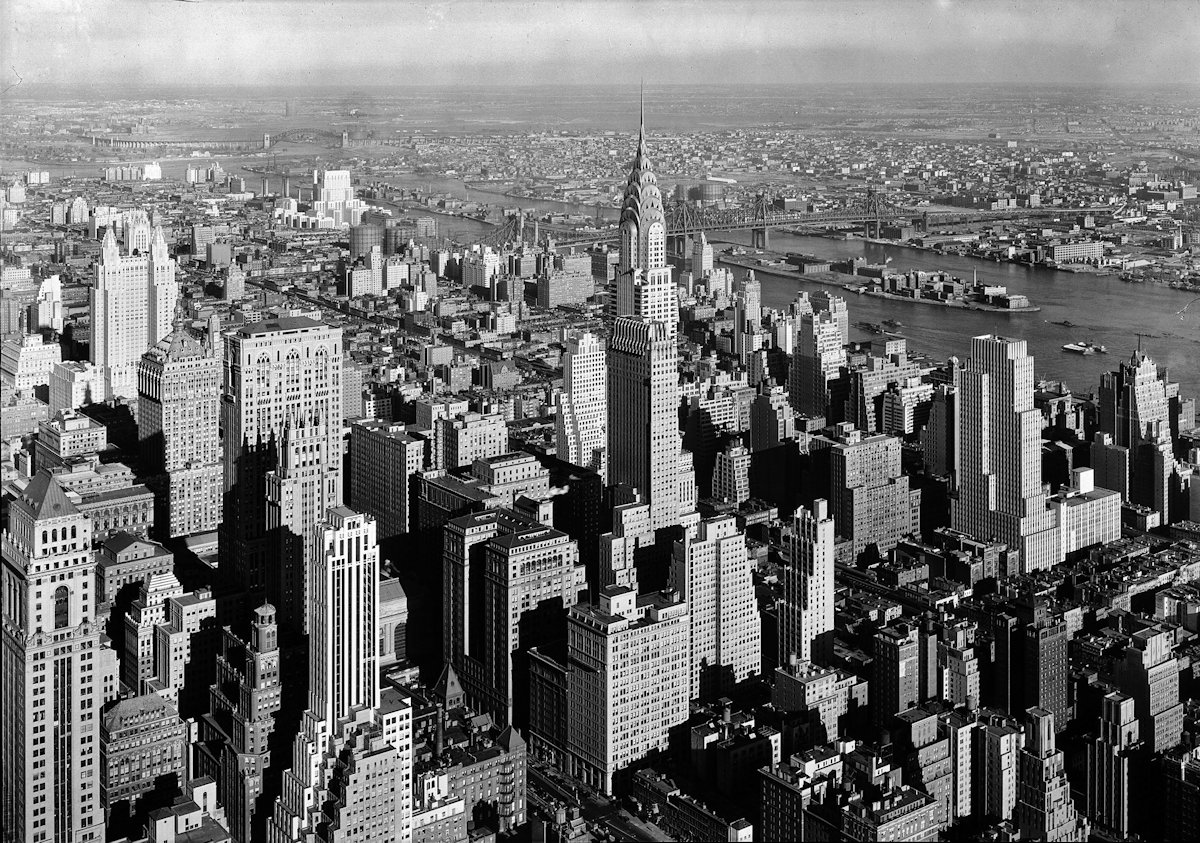
View of power house along East River
This more ominous-looking view of New York City along the East River shows the River House in the foreground, with a smoke-spewing power plant beyond. Though the photo was taken in 1931, it brings to mind the grittier New York of the Industrial Era.
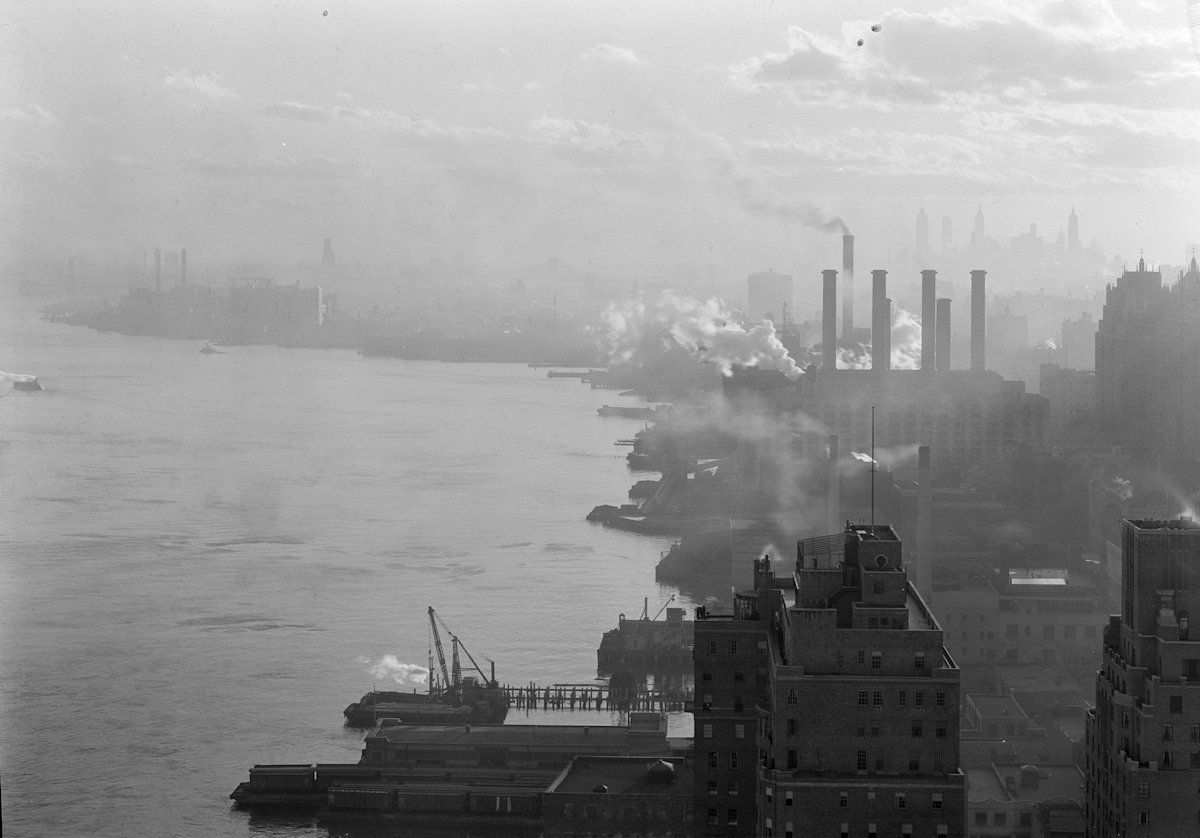
Rockefeller Center and the RCA Building in 1933
In Midtown Manhattan, the 22-acre Rockefeller Center consists today of 19 commercial buildings, one of which is pictured here in 1933. Then, it was the RCA Building, but is today known as the Comcast Building, or simply 30 Rockefeller Plaza. This view is from the DuMont Building at 515 Madison Ave.
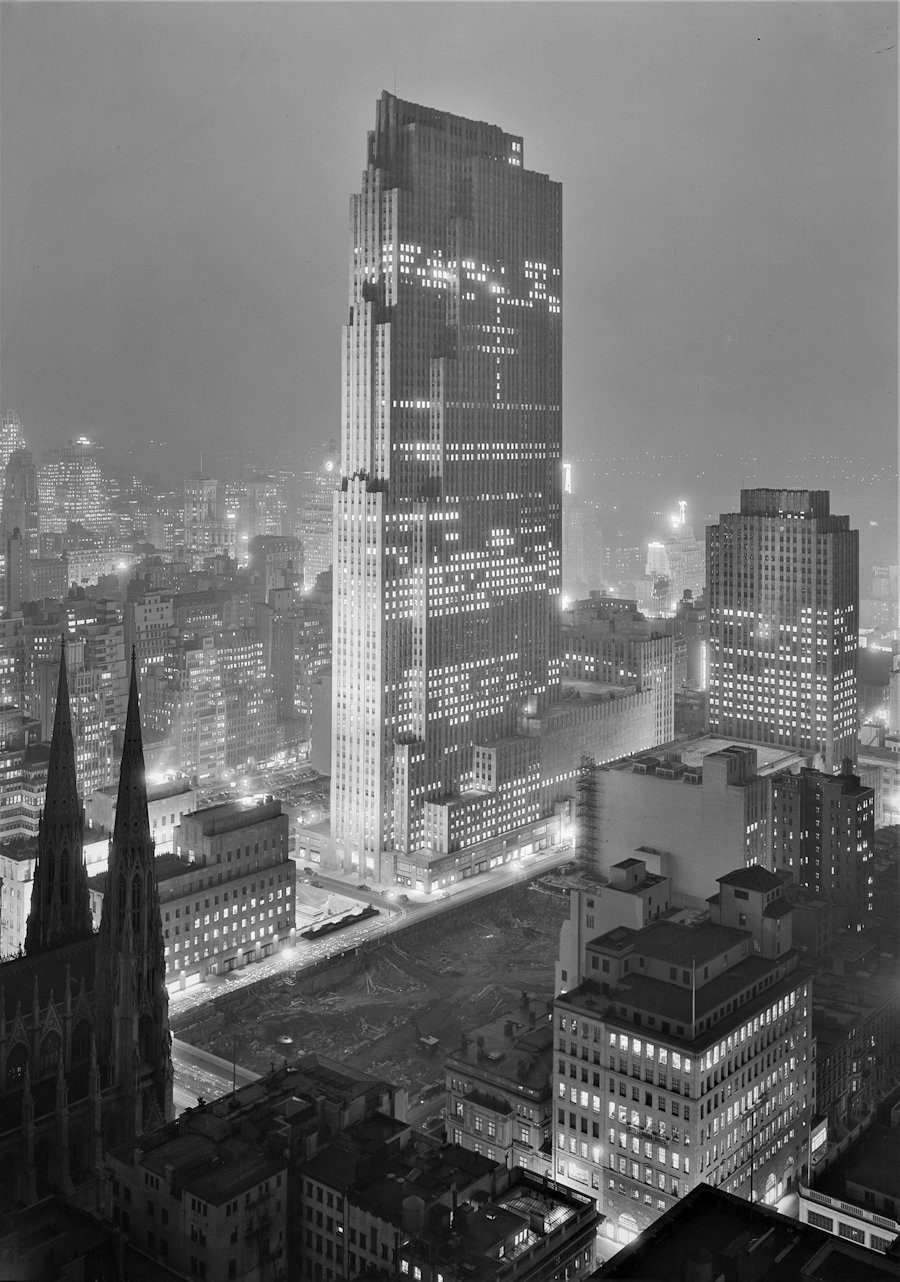
Looking down South Street in New York City
Brick buildings and fire escapes, skyscrapers and the Brooklyn Bridge – how much New York City can you fit into one photo? Away from the glitz and glamour of Rockefeller Center and the Radio City Music Hall, we’re reminded that the Big Apple is also home to everyday folks who show up along the seaport to put in a hard day’s work.
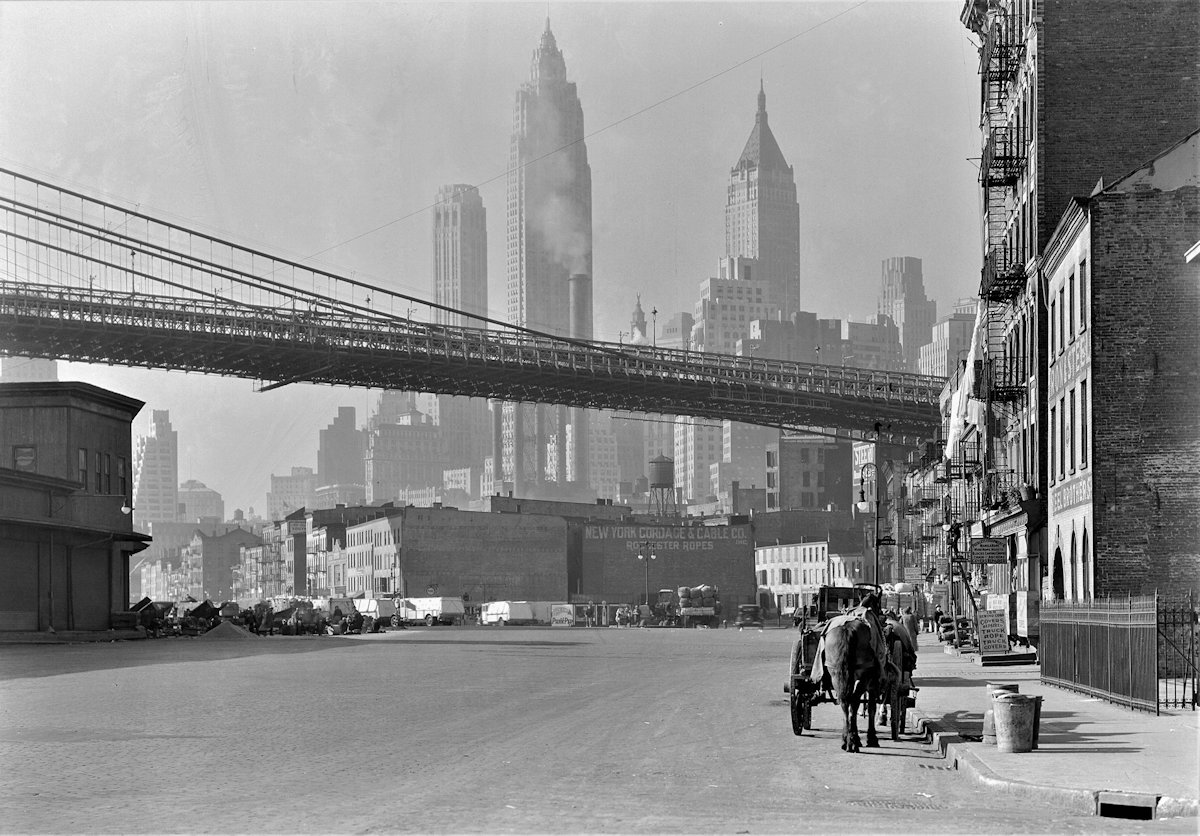
Looking north from the Empire State Building
This amazing photo from Gottscho-Schleisner captures just about everything north of the Empire State Building, including Central Park, the RCA Building in Rockefeller Center, the Hudson River to the left and the East River to the right, and hundreds if not thousands of buildings in between. It’s hard to believe that even way back in 1933, the city was this densely populated.
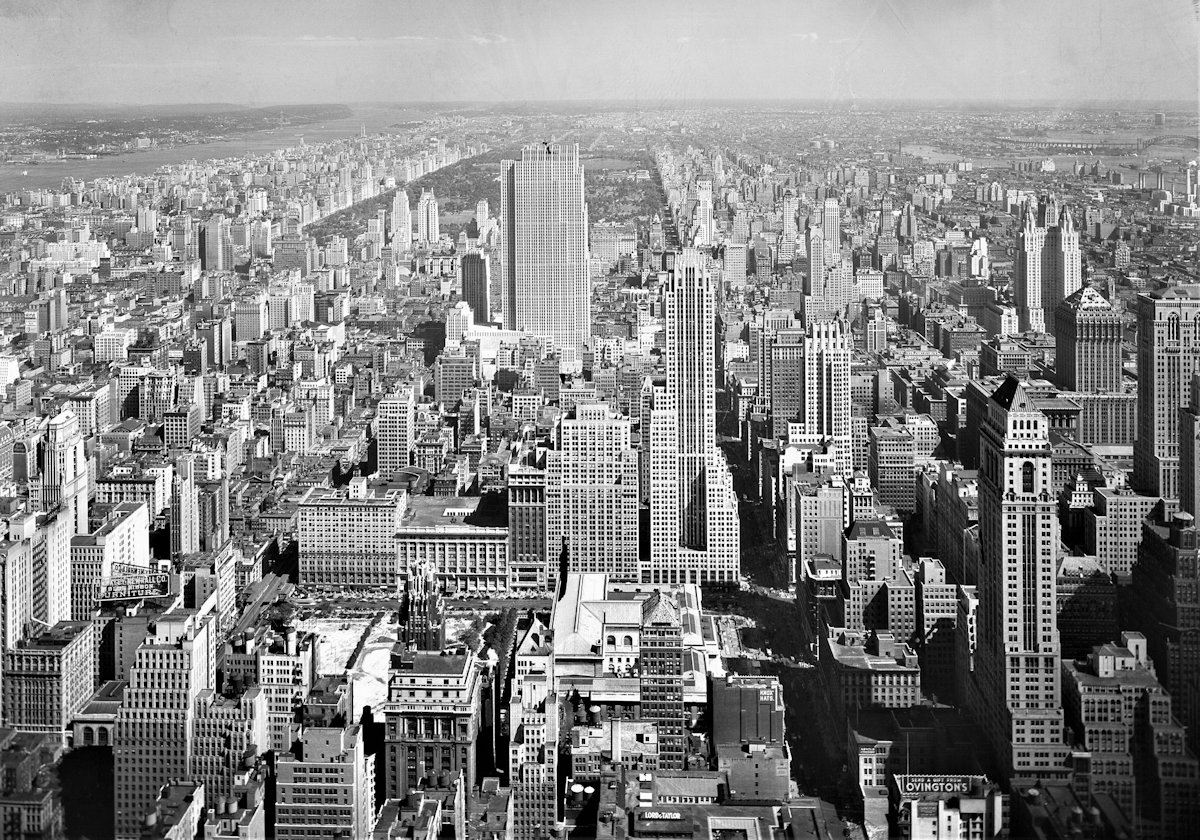
Teens hanging out in front of hardware store
In Midtown Manhattan, on West 38th Street near 7th Avenue, teenagers while away the time by hanging out in front of a hardware store. One busies himself reading the newspaper, while the other idly watches passers-by. The hardware store has quite the array of items in its display window, but what we can’t get over is the marbleized toilet seat front and center!
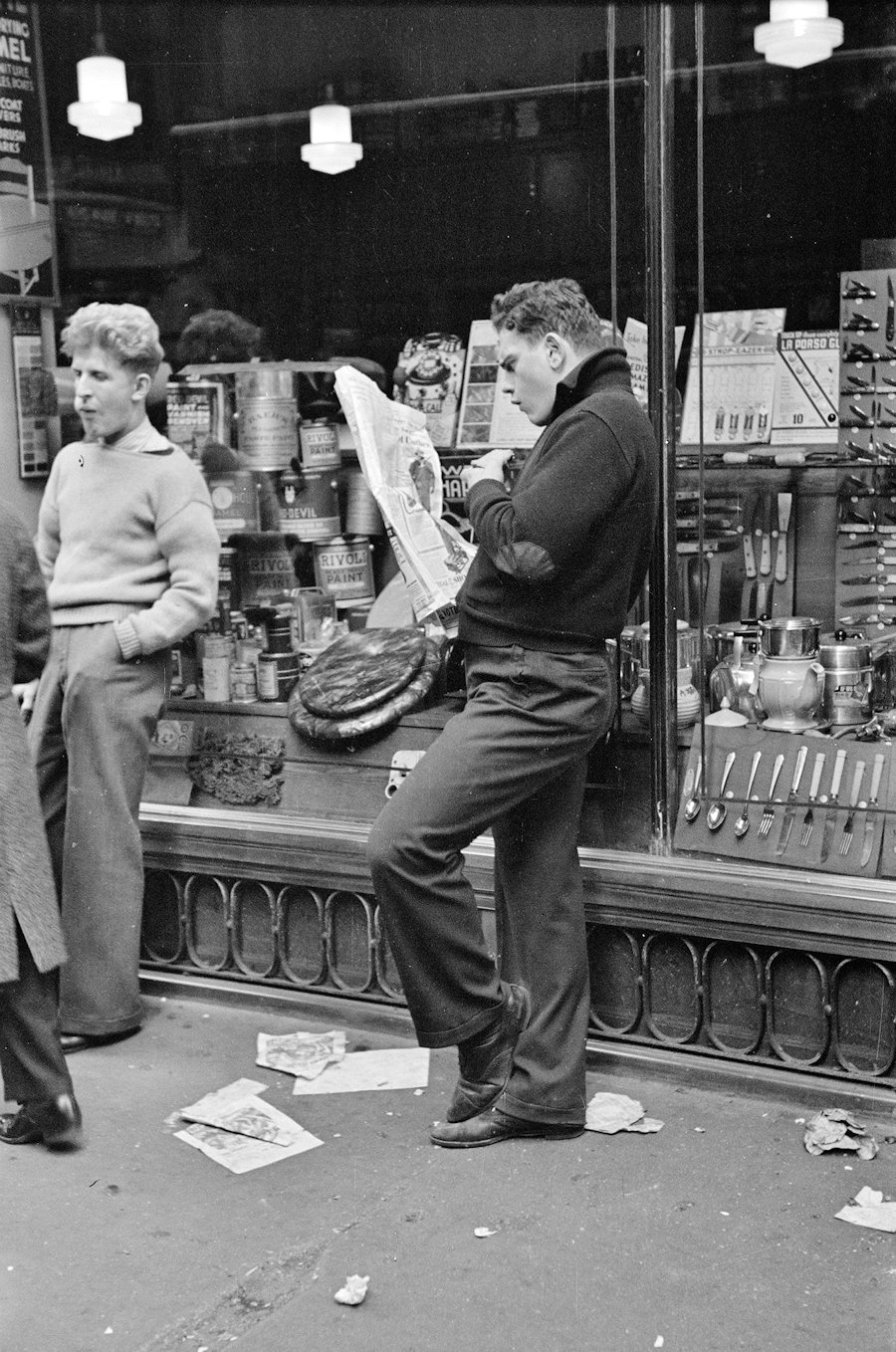
Crowded street scene in 1936 New York City
Oh, the stories we could craft about this street scene in Midtown Manhattan! From the two men carrying the heavy package down the middle of the street, to the crowd of people gathered on the sidewalk, and even the two men standing just off the curb who seem to be watching or waiting for something. There’s so much going on here, it’s hard to take it all in!
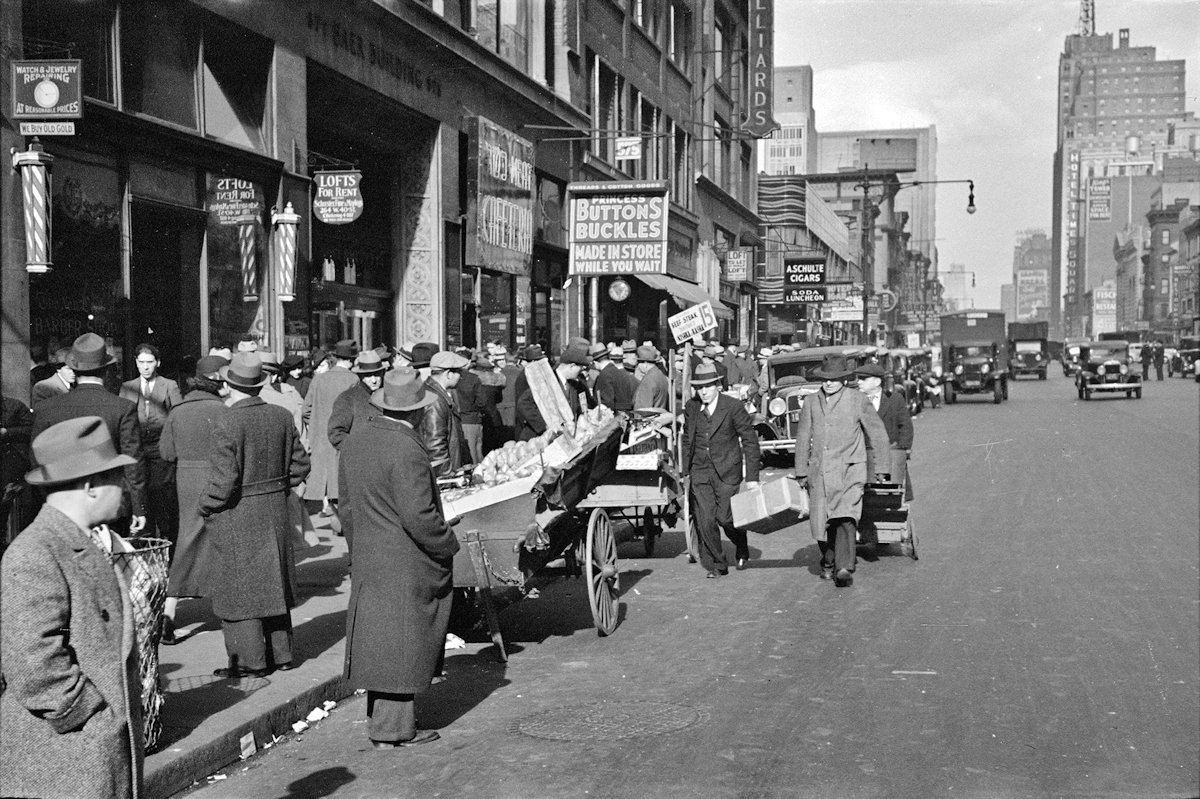
Street vendor on a busy New York City street in 1936
Soap, anyone? That’s right – believe it or not, this man isn’t selling religion, he’s selling soap. For scaly skin and dandruffy hair, this soap promises to cure all your bodily woes. During the Great Depression, you’ve gotta do whatever you can to survive, and this guy seems to have found something that works for him.
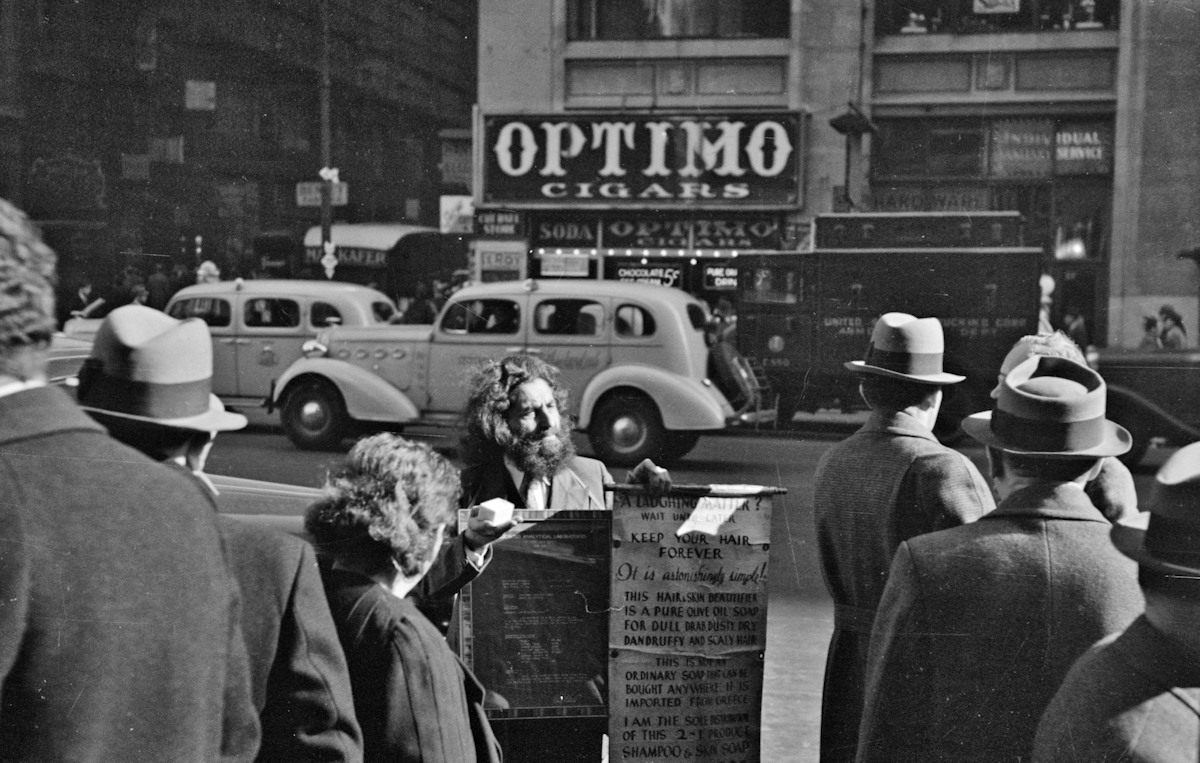
The Empire State Building on the Fourth of July
It’s been scaled by King Kong, has served as a meeting place for several romantic movies, blown up by a UFO in “Independence Day”, and featured in countless other films over the years. In 2022 it was named the #1 Attraction in the U.S. by travelers, and is no doubt one of the country’s most recognizable landmarks. It’s pictured here on the Fourth of July in 1933, just a few years after it’s opening, with the stores of 5th Avenue filling the foreground.
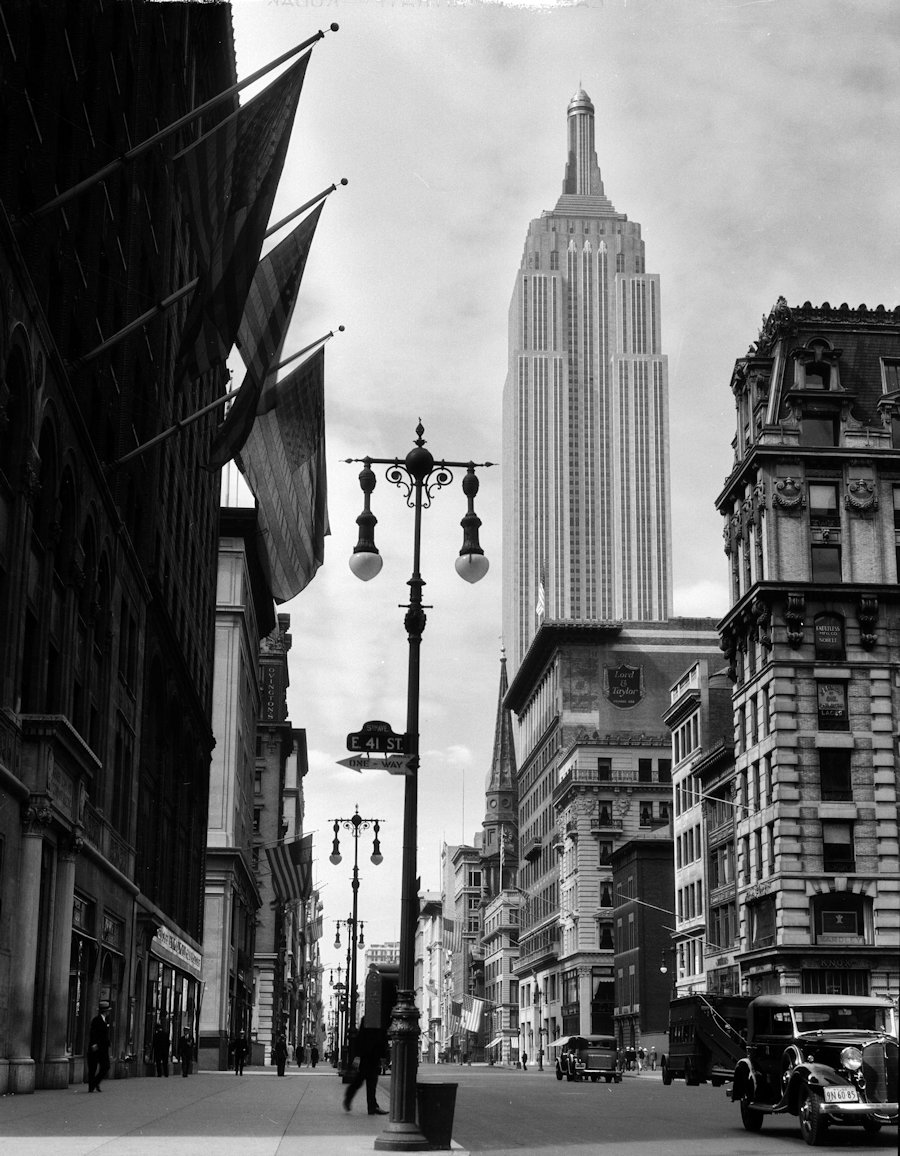
Scene along Bathgate Avenue in the Bronx
This is one of those photos that’ll most certainly leave you scratching your head. Did someone just throw all their trash out that open window on the second floor, or did Tom Cruise just come flying through on a motorcycle in an action sequence, leaving a trail of destruction in his wake? Your guess is as good as ours.
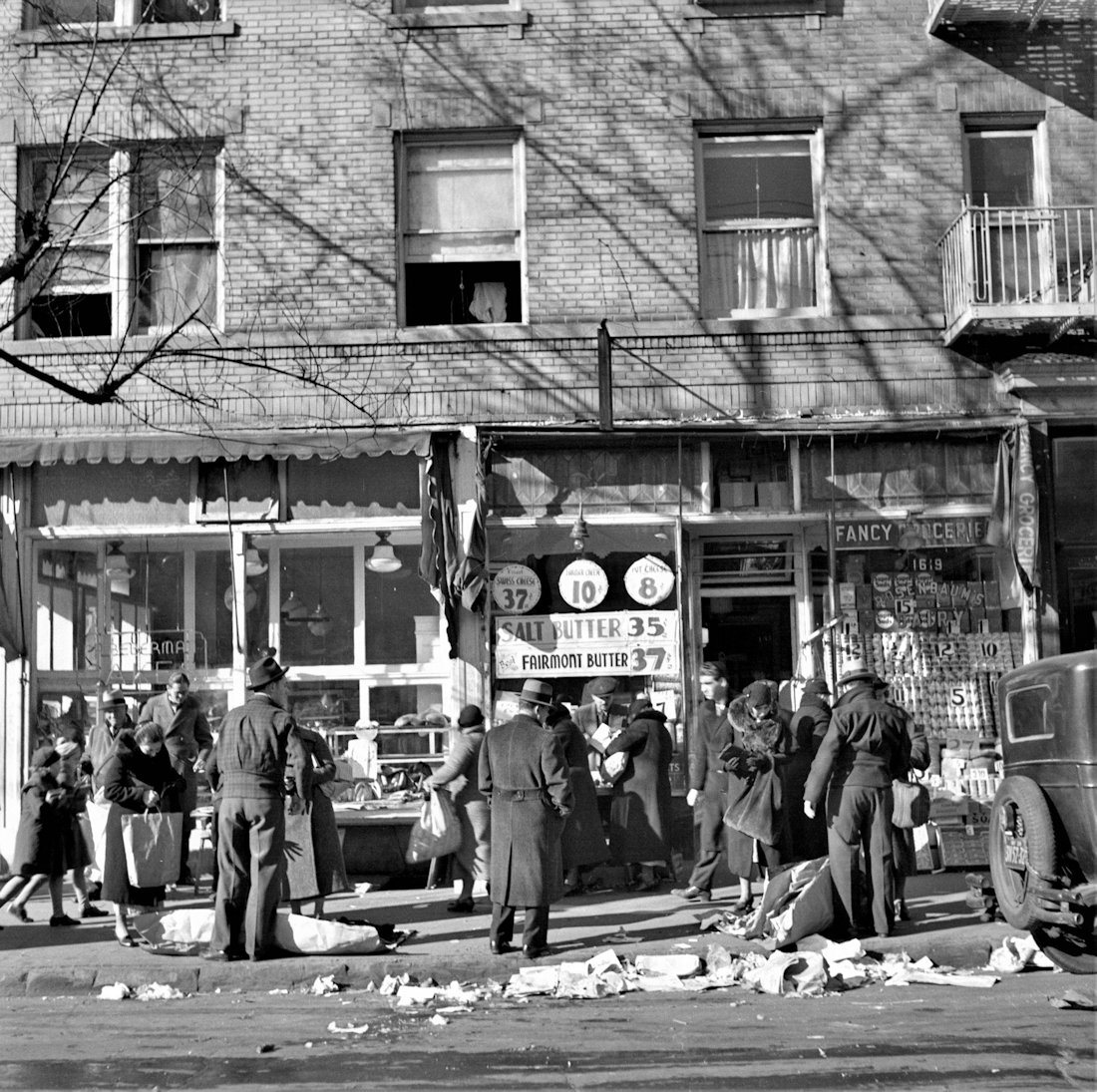
Workman on the Framework of the Empire State Building
Constructing skyscrapers is not a job for the faint of heart, that’s for certain, especially in the 1930’s when this photo of the Empire State Building was taken. This wrench-wielding worker sits squarely on a steel beam, over a thousand feet in the air, without a safety harness or line in sight. Many structural workers of that time are above middle-age. The Chrysler Building stands tall in the distance.
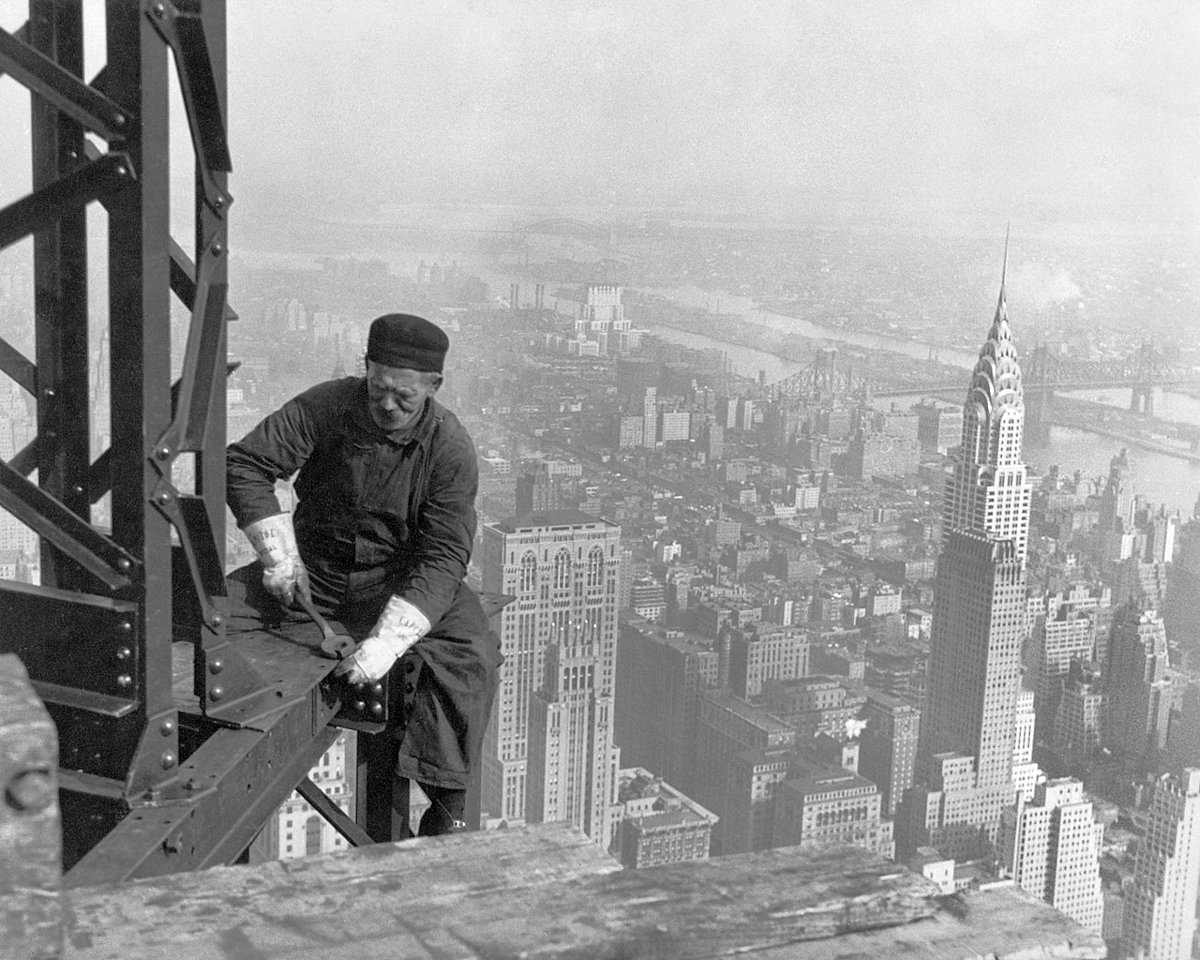
Blossom Restaurant in the Bowery
Welcome to the Blossom Restaurant, where Pigs Head and Oxtail Stew are featured items on the menu, and nothing costs over 30 cents. On a budget? Soup and bread will only set you back a nickel. When your stomach is satisfied, pop in next door for a haircut and shave, or an electric massage – or for the ladies, how about a hairbob?
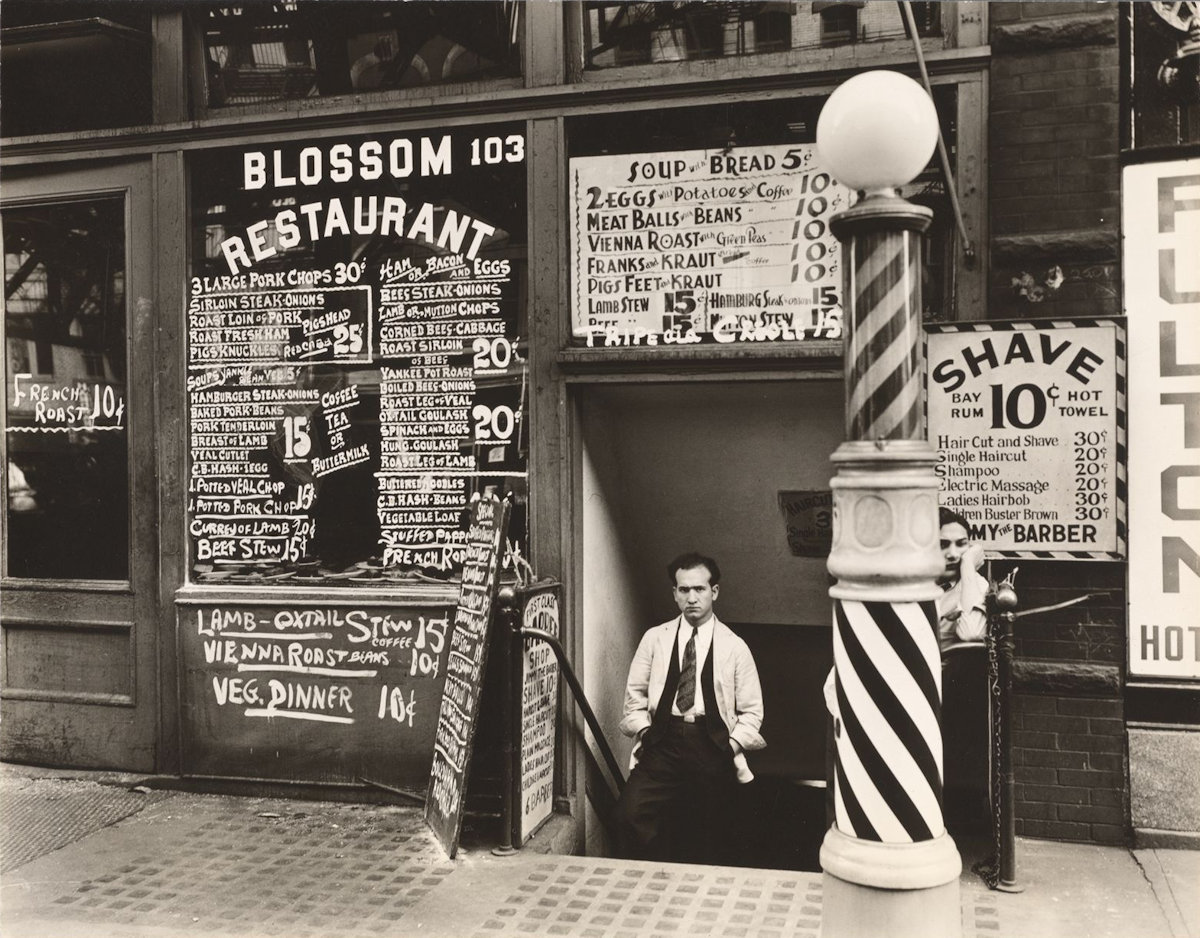
Street lighting in New York City, 1935
From the “Changing New York” collection by Berenice Abbott, this photo from October 1935 was taken near the intersection of Oak and New Chambers Streets in Manhattan. What appears to be getting changed here are lightbulbs from the overhead strings of lights, by the two men in the street waiting by the ladder. Yes, the ladder that looks to be about two stories tall. Yikes!
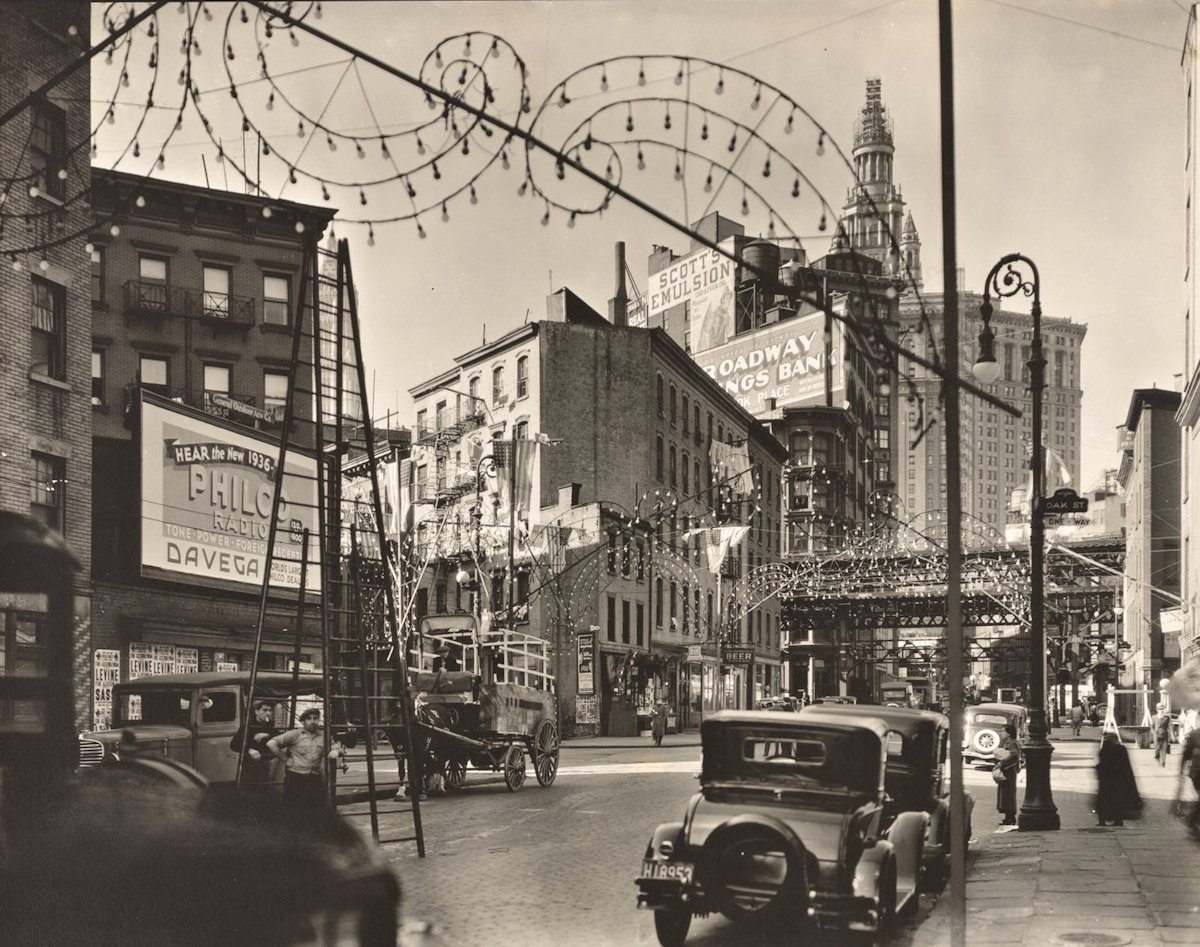
New York skyscrapers reflected in Central Park lake
This stunning 1933 photo by Gottscho-Schleisner features stately skyscrapers reflected brilliantly in the still waters of a lake inside Manhattan’s Central Park. The exquisite architectural detail of the buildings are prominent in this amazing capture, along with the contrasting natural elements in the foreground.
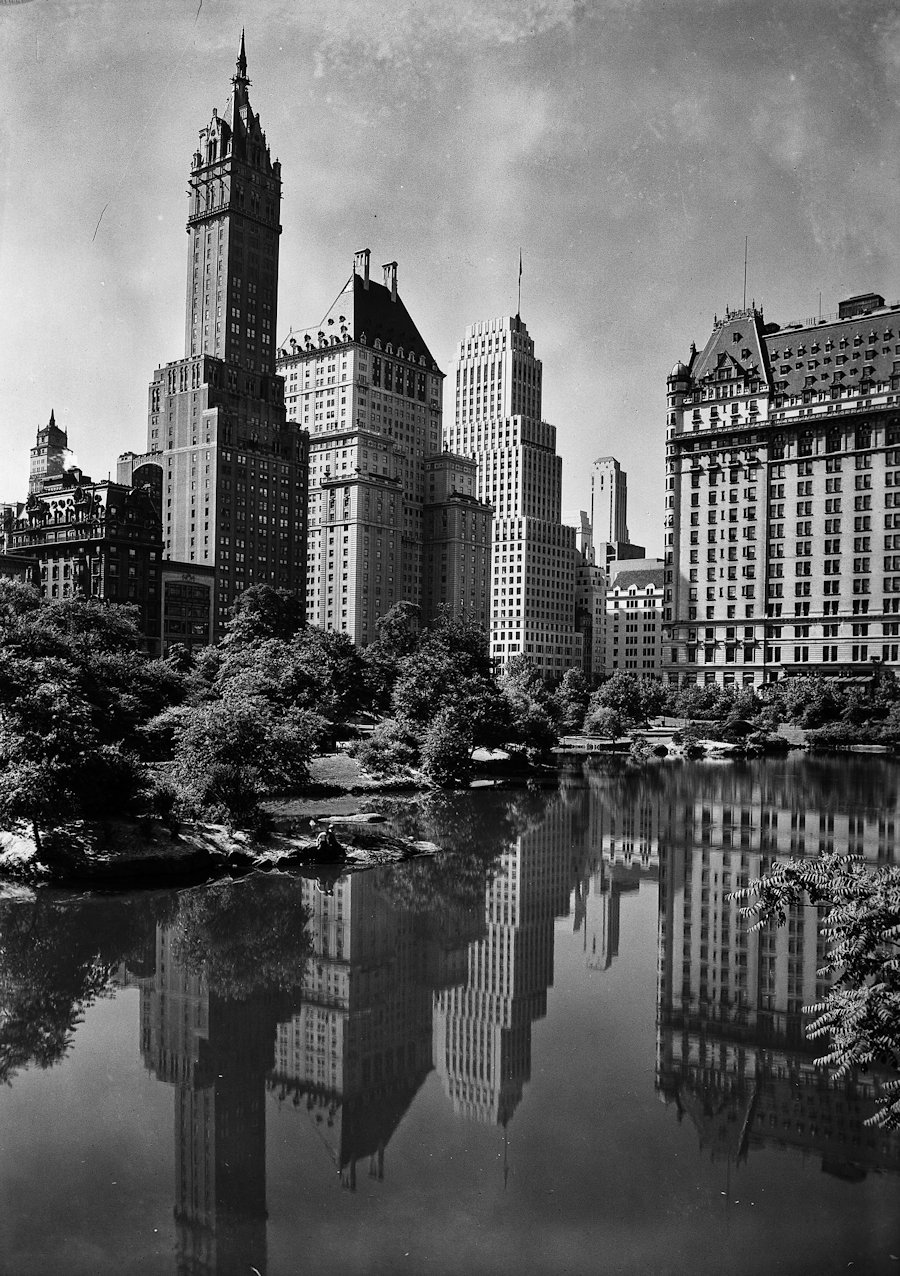
View from the parapet of the River House
Imagine the parties you could have up here! This large outdoor space on the 27th floor of the River House at 52nd St. and E. River offers an amazing view of the city skyline and the East River. The photo was taken in 1931, so the Chrysler Building featured prominently here has only been open for a year.
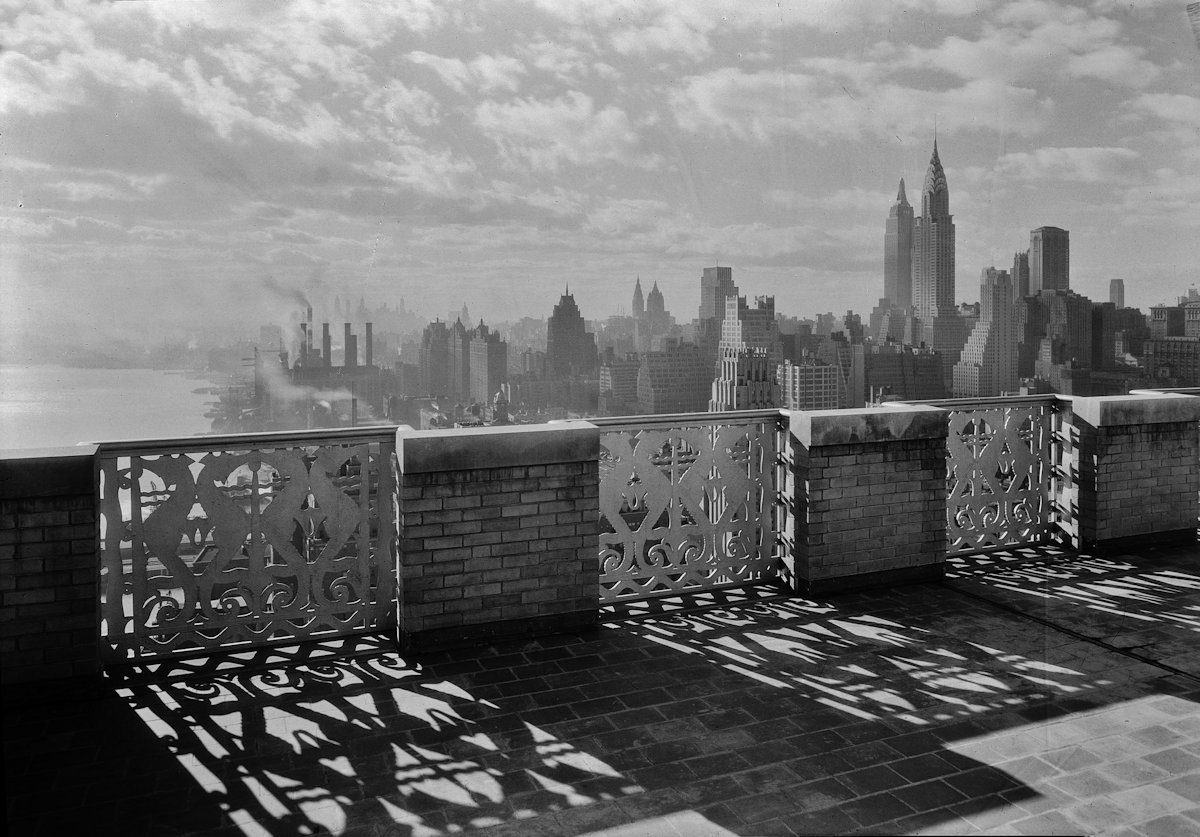
Gramercy Park townhouses with fancy ironwork
The fancy ironwork at the front of these Gramercy Park townhouses in New York City seem to affirm the neighborhood’s affluence. The area has historically been home to a whole host of rich and/or famous residents, including everyone from Thomas Edison and John Steinbeck to John Barrymore and Julia Roberts.

Pedestrians on a busy New York City street corner in 1936
If the pedestrians’ clothing and the cars parked along the curb didn’t give away the age of this photo, the “Typewriter Trading Co.” sign on the building at left would certainly do so. Taken in 1936 at the corner of Broadway and Thomas Street, one can definitely appreciate the architecture despite the obvious nod to the Great Depression with the “Going Out of Business” sign hanging above the store at street level.
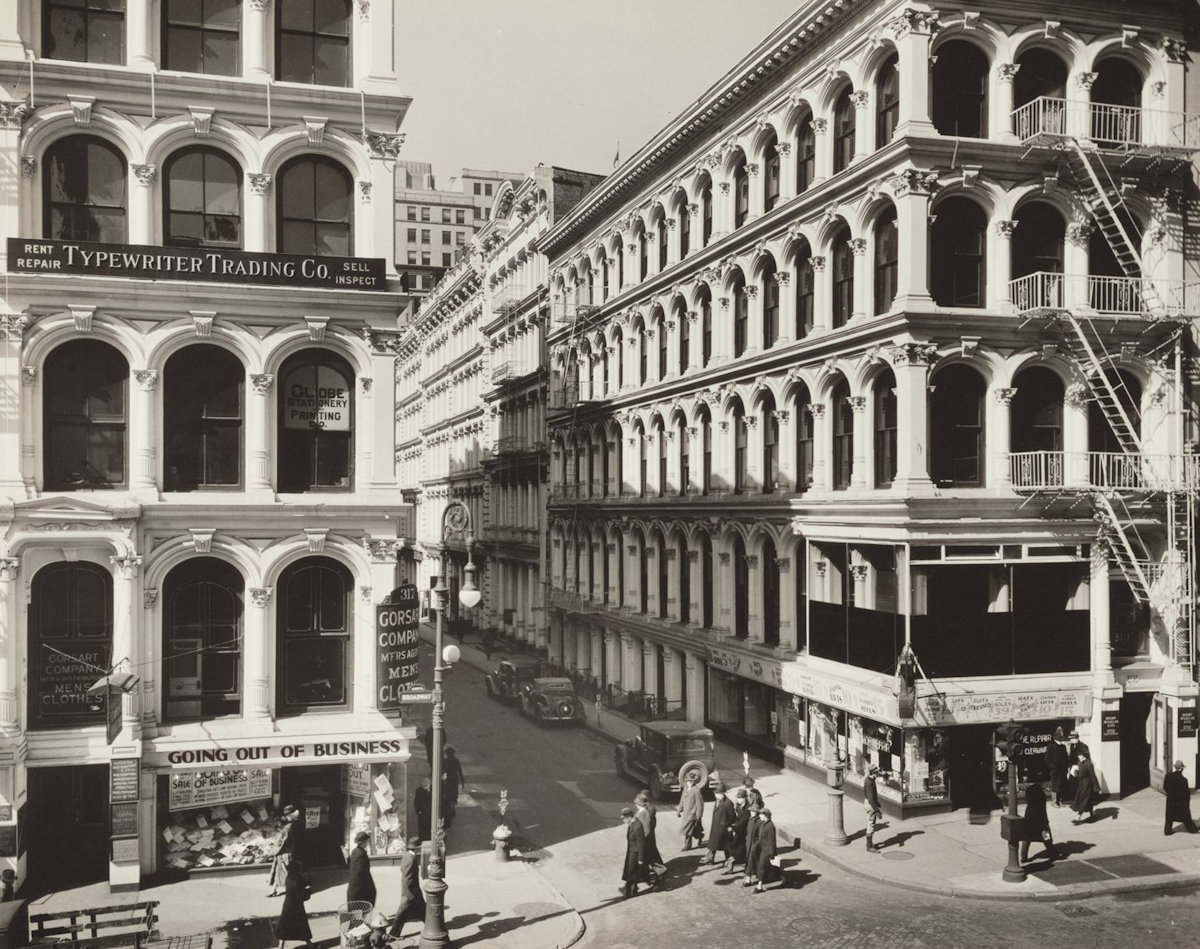
Commuters waiting for the elevated train in New York City, 1936
Long before the New York subway system we’ve all come to know, the city relied on elevated trains to shuttle passengers around town. Here, a few riders wait for the next train at the El Station for the Sixth and Ninth Avenue Lines downtown at 72nd Street and Columbus Avenue. Just two years later in 1938 these lines shut down for good, and the tracks demolished soon after.

Madison Square in NYC showing William Henry Seward Monument
Although Madison Square, as well as the park it contains, are both named for our nation’s fourth president, James Madison, the area is home to several monuments celebrating other historic figures, including this one of William Henry Seward. Prior to serving as United States Secretary of State under Abraham Lincoln, he was a New York native who served as governor of New York and as a United States Senator.

New York’s Radio Row on Cortlandt Street in 1936
New York City’s Radio Row was a several-block area of radio-related stores that got its start in 1921 with City Radio, and was the starting point for a number of electronics firms including Arrow Electronics and others. Despite a slump during the WWII years due to wartime scarcities, it rebounded soon after, only to meet its final demise in 1966 when it was torn down to make room for the World Trade Center.

Restaurant unloading areas along West Street Row
On Manhattan’s west side, along the Hudson River, what is now known as West Side Highway was once called West Street. This photo from 1936 appears to show several trucks and a wagon carrying restaurant supplies for the restaurants along the row. The cobblestone street is just one of many such streets that weaved their way through the city. Surprisingly, some still remain today.
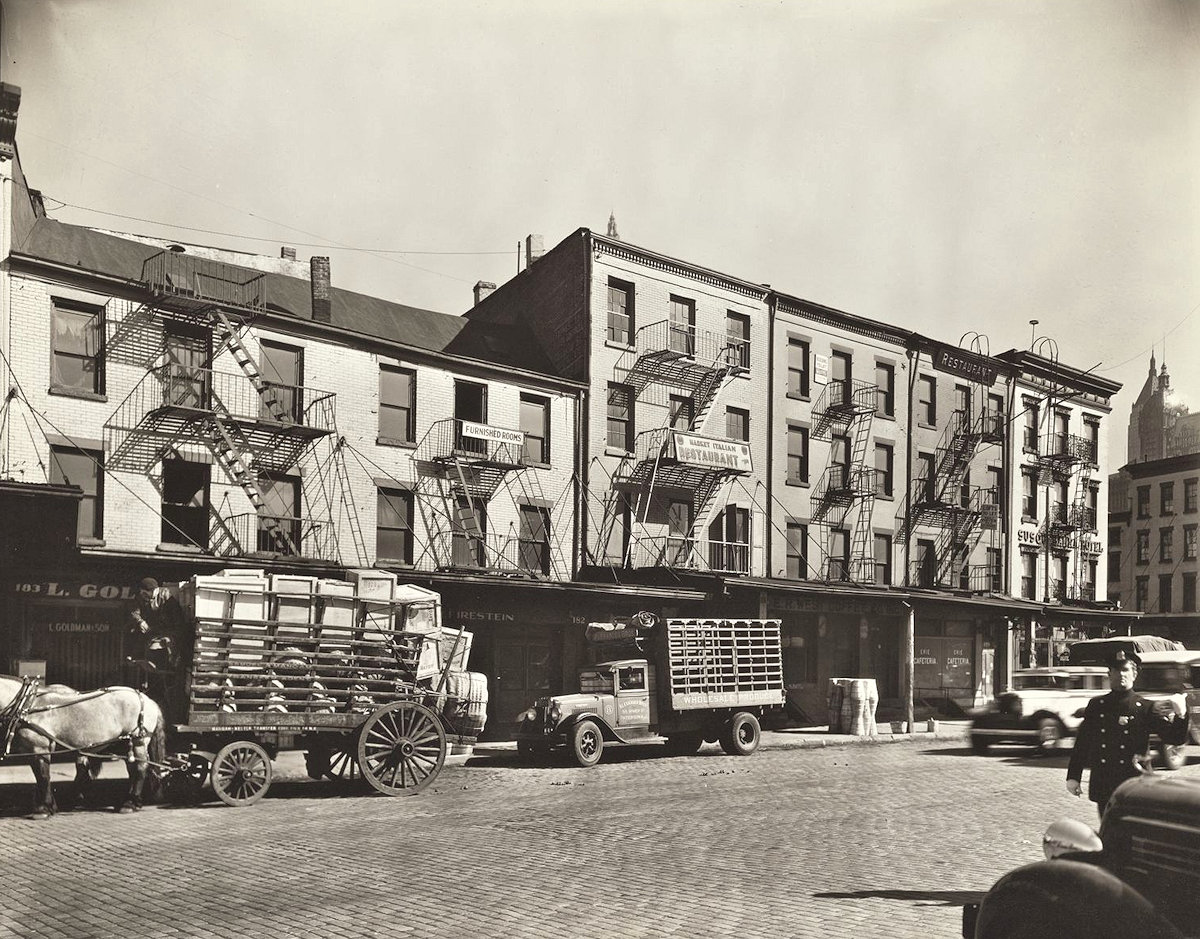
Map seller in front of Department of Docks building in New York City
This photo from 1936 features the Dept. of Docks building, which also houses the police station, at Pier A in Lower Manhattan. The original caption refers to the North River, which actually refers to the southern end of the Hudson River, and a name that has fallen out of use. Regardless, it’s a cool photo, and we wonder just what all those different maps are that the guy in the foreground is selling!
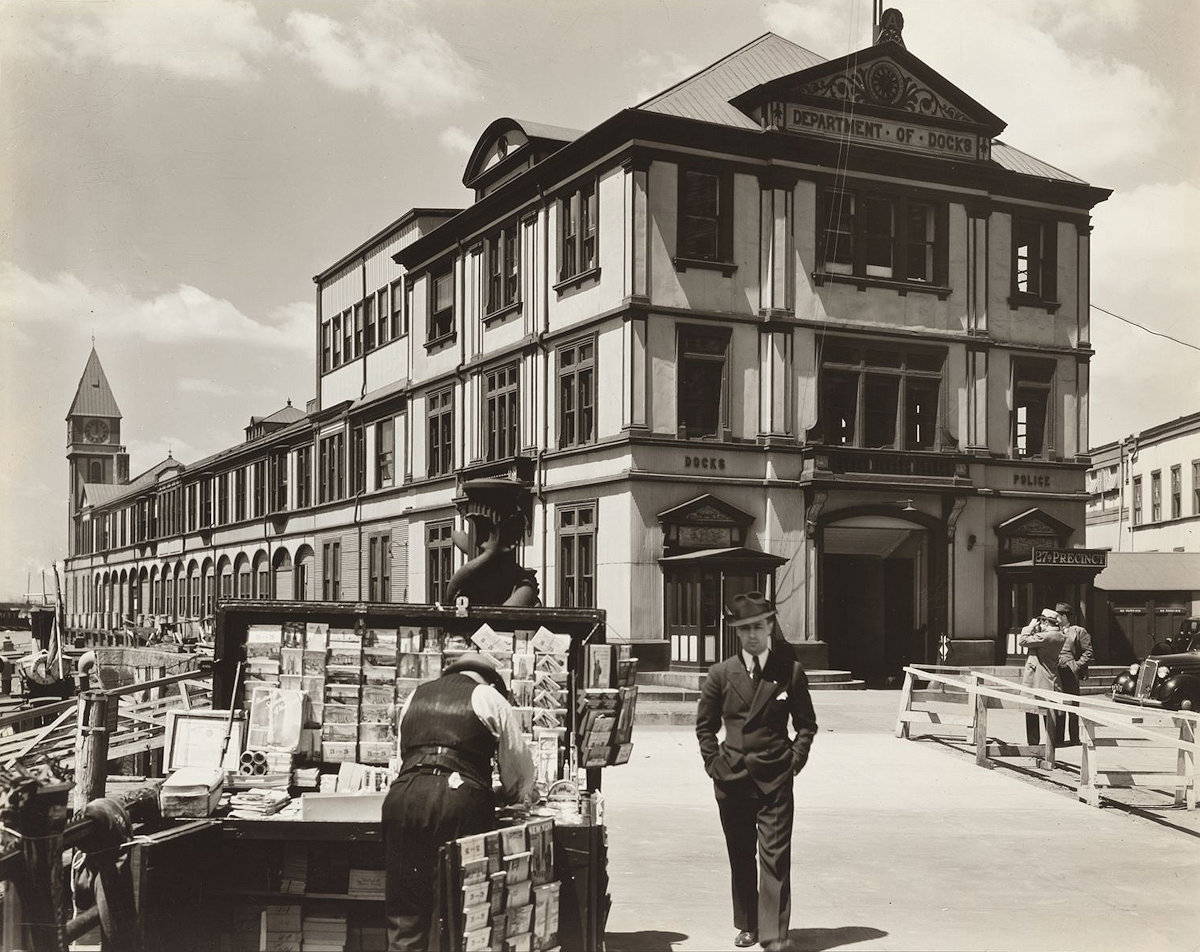
Traveling Tin Shop in Brooklyn NY in the 1930s
No need to head to the home goods store, it’ll come right to you! This enterprising fellow has his wagon loaded up with an entire line of tinware for your kitchen. By the looks of things, this isn’t any side gig, either – he’s got enough product there to open his own shopping mall.
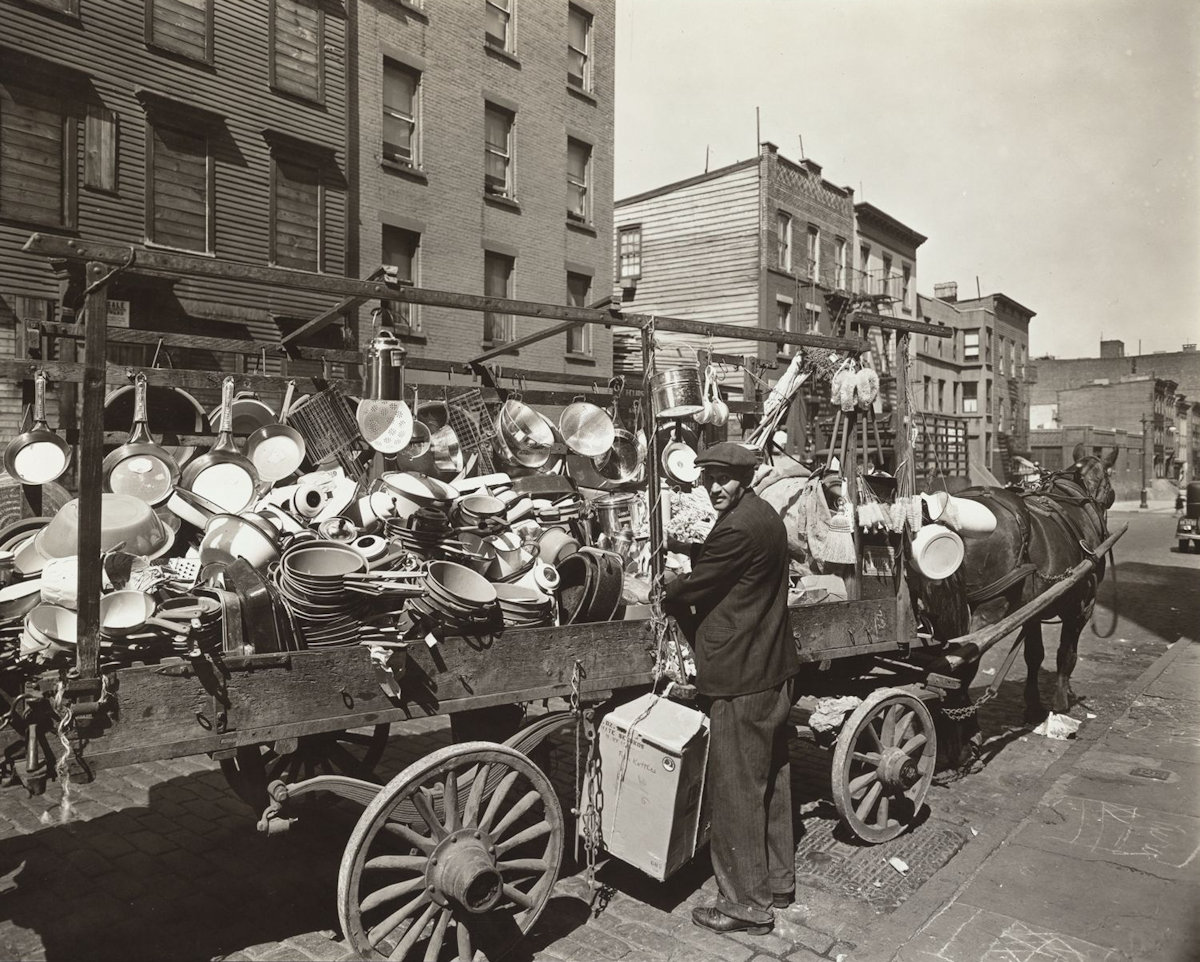
West Street Row businesses in New York City, 1936
It may be the middle of the Great Depression, but it’s business as usual on West Street, where delivery trucks are dropping their loads in front of merchants’ buildings so the wheels of commercial enterprise can keep on turning. Featuring everything from packaging supplies and auto accessories, to syrup and fresh produce, these businesses prove that if you can’t find it in New York City, you can’t find it anywhere.
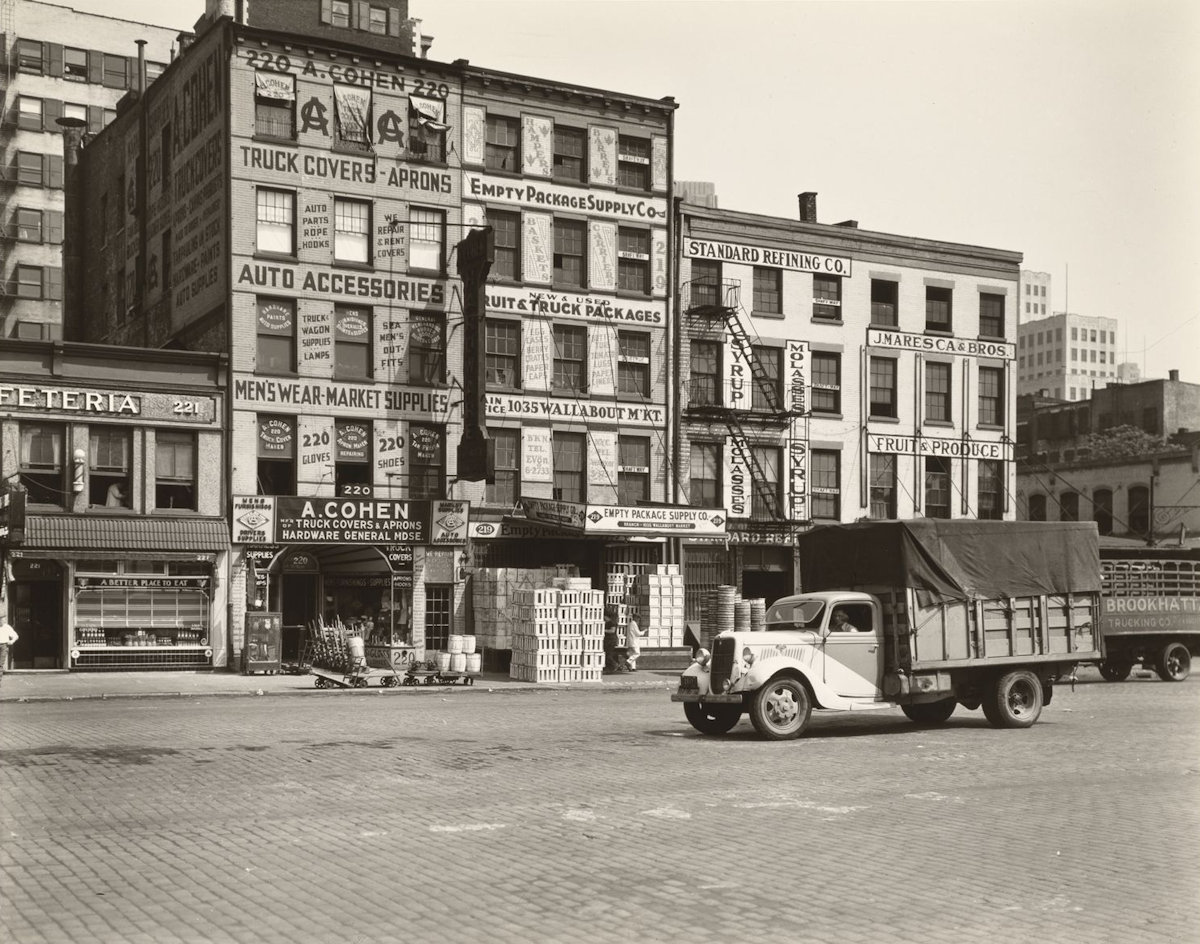
Chambers Street Ferry Terminal in 1936
During the second half of the 19th century and well into the 20th century, many commuters from outside New York City would take the train to Jersey City, then take a ferry across to Manhattan. The Chambers Street Ferry Terminal was one of several that operated during this time period, until passenger rail travel declined in the mid-20th century and the terminal closed for good in 1958.

Tellas Busy Bee Hot Dog and Lemonade Stand
Let’s face it, it just wouldn’t be New York without a hot dog stand on every corner. This guy’s got his corner all staked out, at West St. and North Moore, with a nice view of Jersey City right across the river. This photo, along with many others pictured here, is part of the “Changing New York” collection by Berenice Abbott from 1936.

Street corner in Brooklyn with view of Manhattan
A tree may grow in Brooklyn, but not on this street – and don’t let the street names of Willow and Poplar fool you, either. It’s all concrete and steel here, with a little steel thrown in for good measure. It’s a quintessential urban view, save for the horse-drawn wagon parked along the curb behind all the modern automobiles of the day. With Manhattan in the distance, it’s a perfect New York City scene.

Brooklyn Heights brownstone with view of Manhattan
It may look like something out of a Hitchcock movie, but this elegant brownstone in Brooklyn on Columbia Heights is mere steps to the East River, and boasts an amazing view of downtown Manhattan. At 222 Columbia Heights, it’s less than a mile from the Brooklyn Bridge. This very typical brownstone is three stories tall, with a fourth level – the basement – a half floor below the street level, and the main floor above street level.
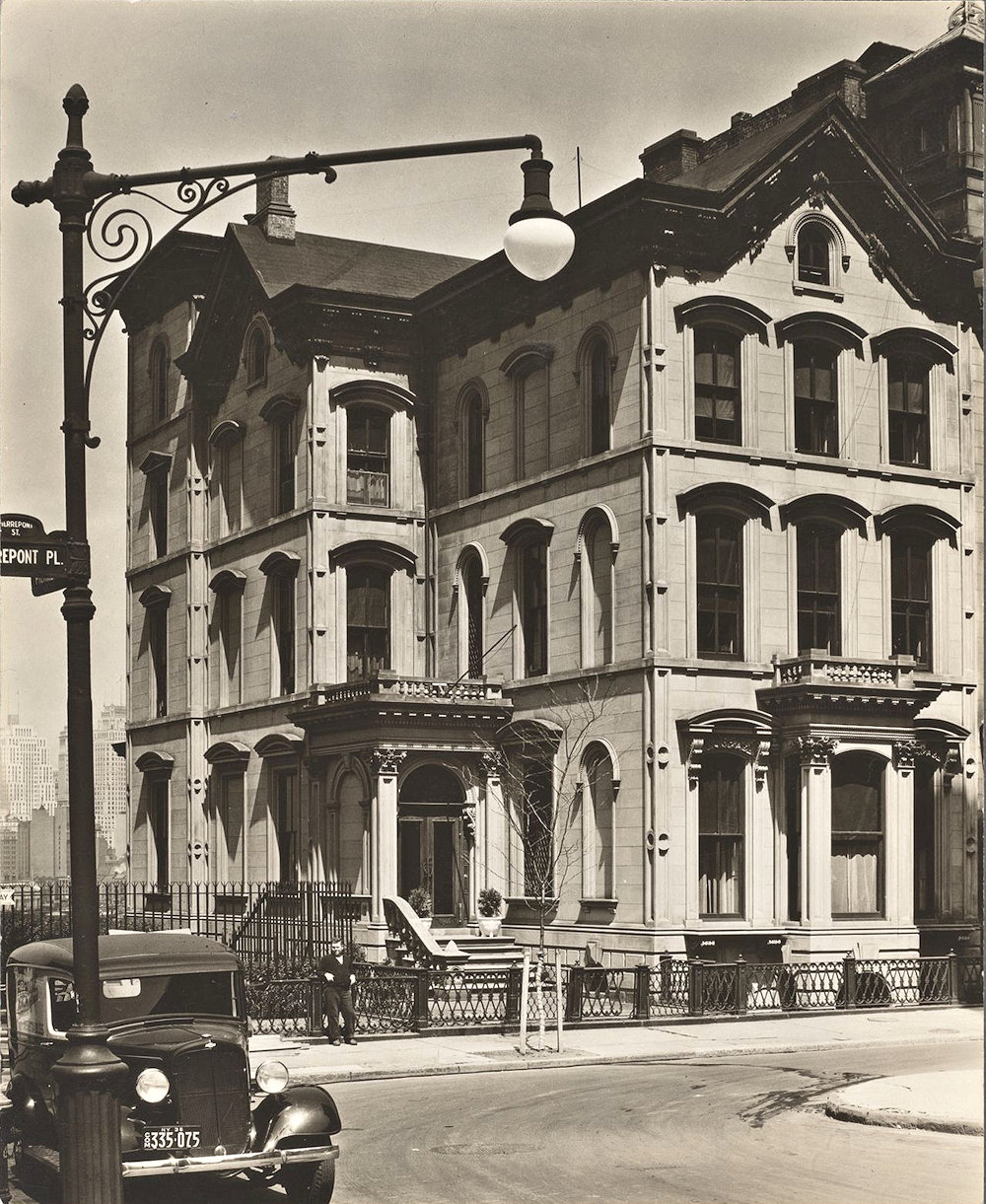
Bustling Herald Square in New York City, 1936
There is so much going on in this New York City scene that we don’t even know where to start. From taxi cabs and city buses, to the sidewalks and streets crowded with people, and vintage signs that take you back in time. This major commercial intersection at 34th and Broadway in the Midtown Manhattan neighborhood was named for the now-defunct New York Herald, and is still just as busy with shoppers and other New York City residents today as it was way back in the 1930’s. You definitely won’t find the plethora of women in long dresses and fancy hats and men sporting suits and fedoras like you see in this photo, though!
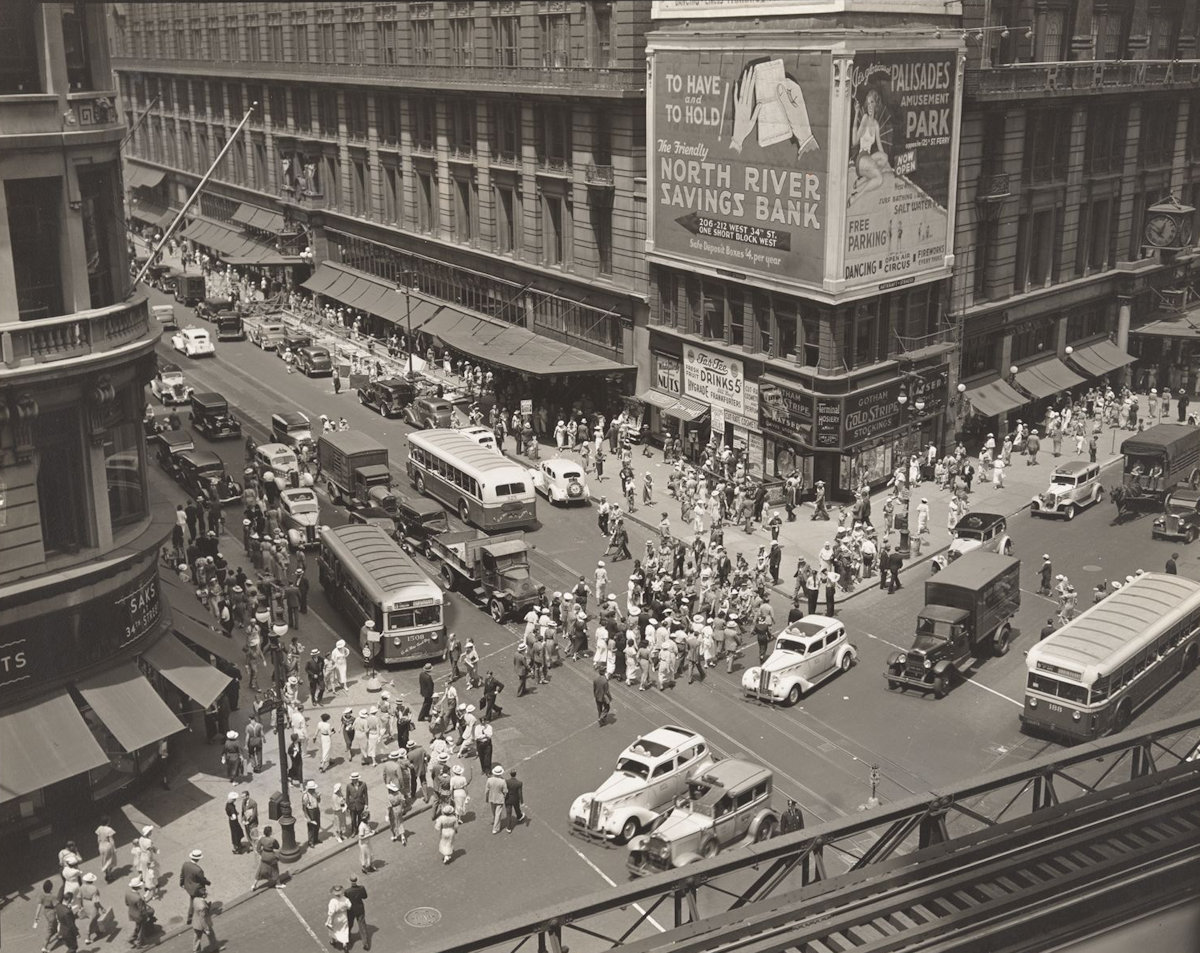
Radio City Music Hall stage with curtain down
Originally known as the International Music Hall, the famous New York City landmark is shown here in early December 1932, just weeks before its grand opening. This Art Deco theatre, headquarters of The Rockettes, was originally intended to host stage shows, within a year of its opening it was converted into a movie palace, and has continued to evolve over the years since into various uses.
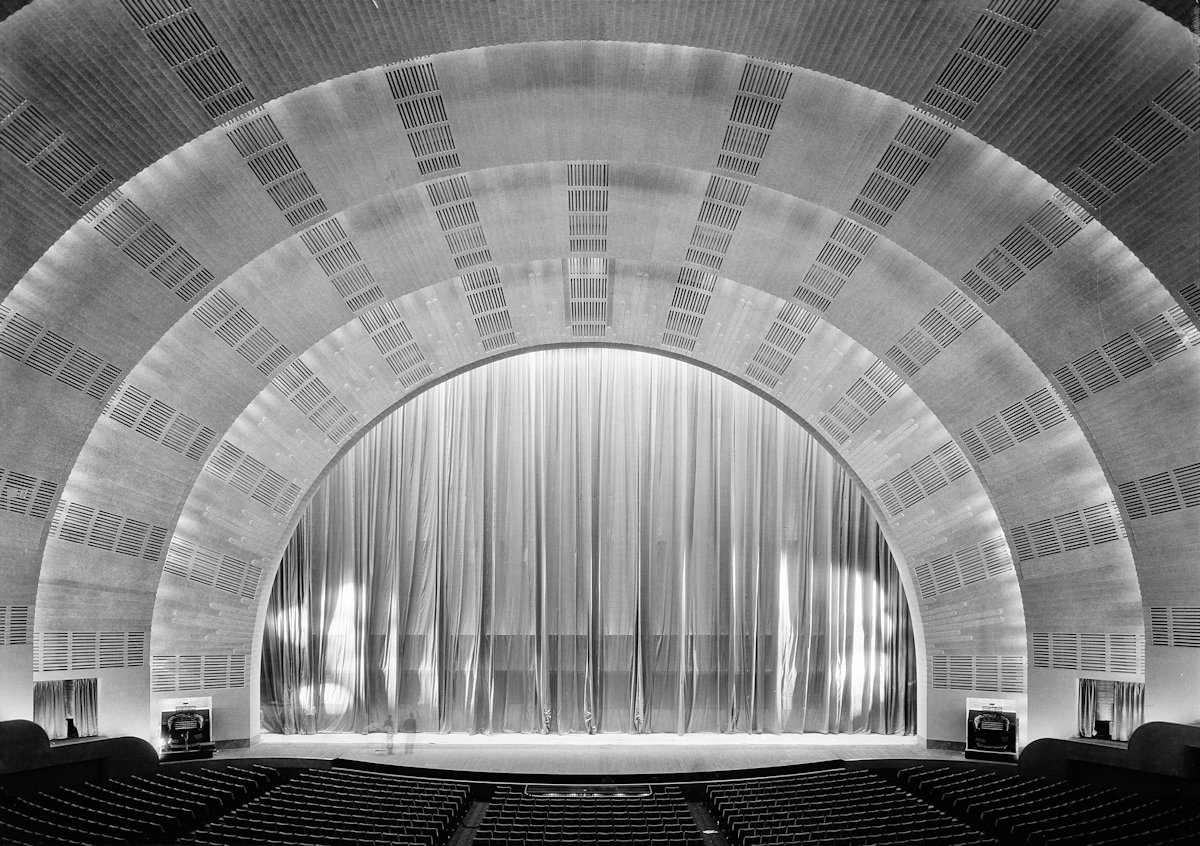
Radio City Music Hall’s Grand Foyer
The 165-foot-long Grand Foyer of the International Music Hall, as it was known in 1932, features a 2400-square-foot mural by Ezra Winter titled “Quest for the Fountain of Eternal Youth”. The Grand Foyer as pictured here remains today, and were designated in 1978 New York City Interior Landmark.
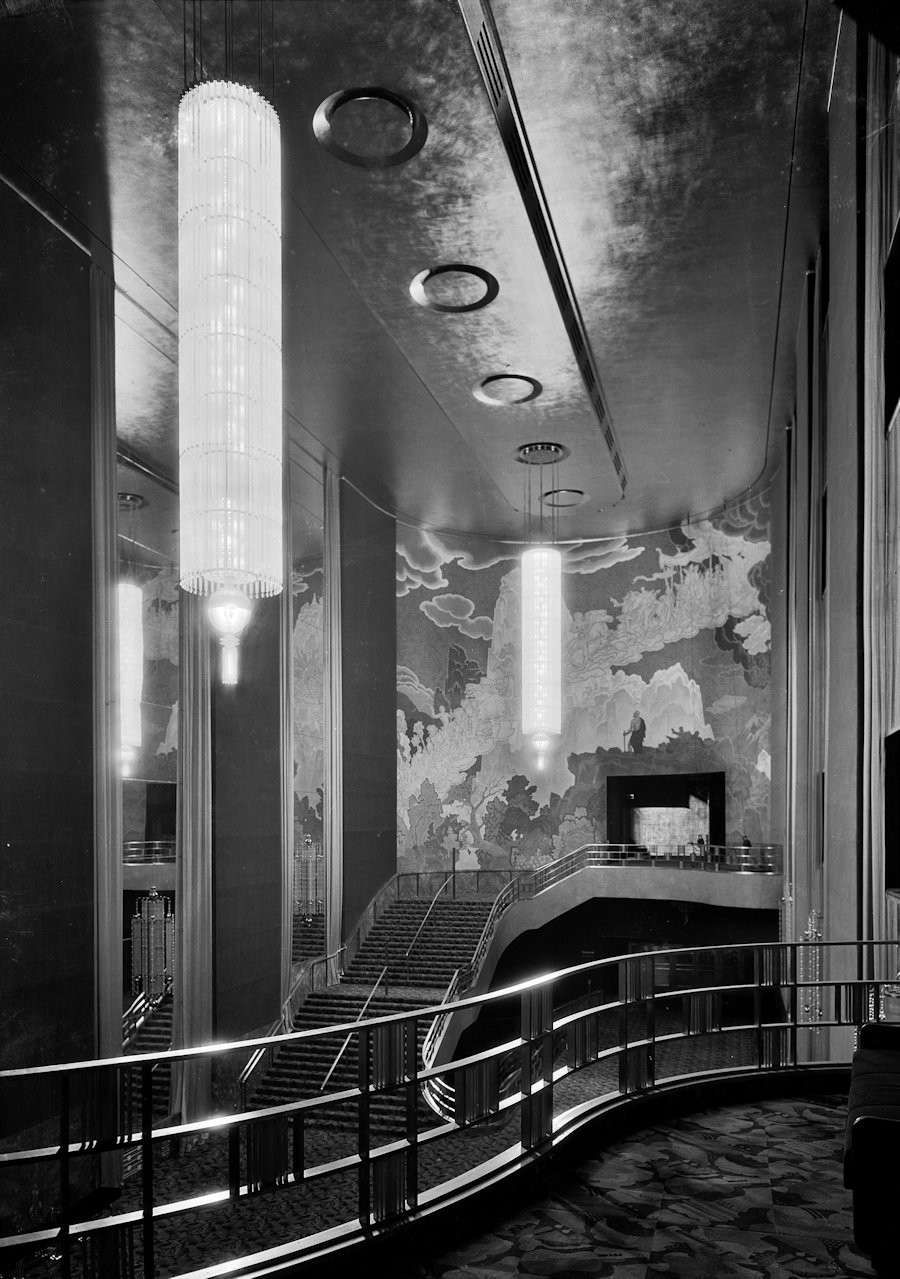
Greyhound Bus Terminal at 33rd and 34th Streets in NYC
For just over 100 years, Greyhound buses have been getting folks from place to place. Even back in the 1930’s, you could go just about anywhere on a Greyhound bus. The 1930’s were also a time of great expansion within the company, and by World War II there were over 4700 stations across the country. The Greyhound station pictured here was located at 33rd and 34th Streets between Seventh and Eighth Avenues in New York City, less than two blocks from the Empire State Building.
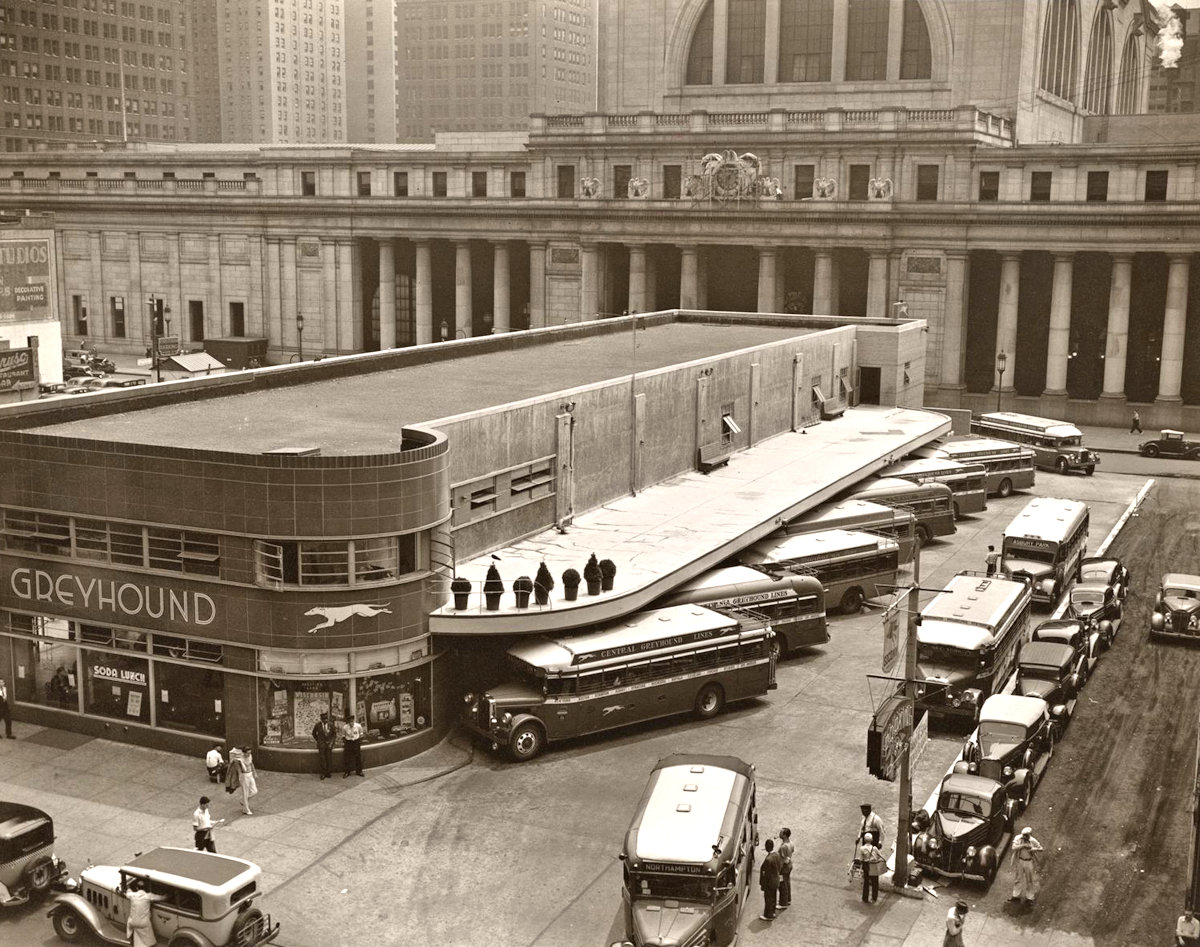
Central Railroad of New Jersey Ferry Terminal
While cabbies wait for fares and vendors wait for shoppers, the Central Railroad of New Jersey goes about the business of getting commuters back and forth across the Hudson River between Jersey City and Manhattan. This terminal on the New York side was located at the foot of Liberty Street in Lower Manhattan, and was one of several that served passengers traveling to and from New Jersey. By the 1960’s ferry service terminated, and the waterfront was filled in to create Battery Park City, a mostly residential neighborhood just west of where the twin towers of the World Trade Center once stood.
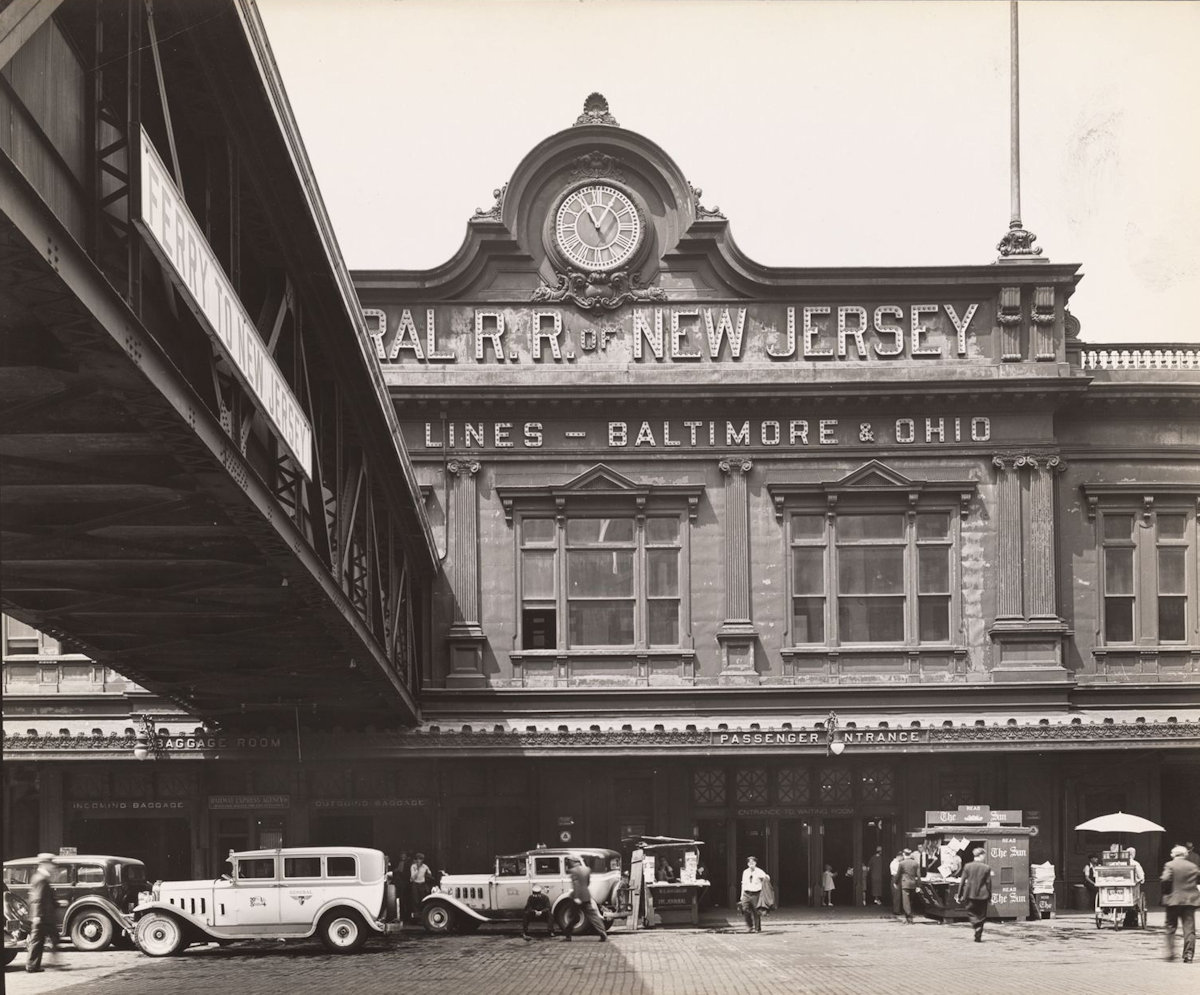
Grand Opera House in New York City, 1937
The Grand Opera House in Manhattan, shown here in 1937, was located on the northwest corner of 8th Avenue and 23rd Street. Built in 1868, it was originally known as Pike’s Opera House, after distiller and entrepreneur Samuel N. Pike. It changed owners and managers several times over the years, and after failing to make a solid go of it as a live theatre, it was converted to an RKO movie theater in the 1930s. Eventually, though, progress came knocking, and the old opera house was demolished in 1960 to make way for a housing development.

Billy’s Bar at 56th and First in New York City
Ol’ Billy the bartender looks like he’s ready for business, but it’s standing room only at this particular establishment! Apparently barstools were not a thing back in the ’30s, but if you want to sit and stay awhile, there are tables. There are plenty of bottles lined up behind the bar, so you definitely won’t go thirsty while Billy’s pouring. And ol’ Billy, he’s from the generation of bartenders that come to work in a collar shirt and tie, so he’ll make you feel like you’re in a real high-class place!
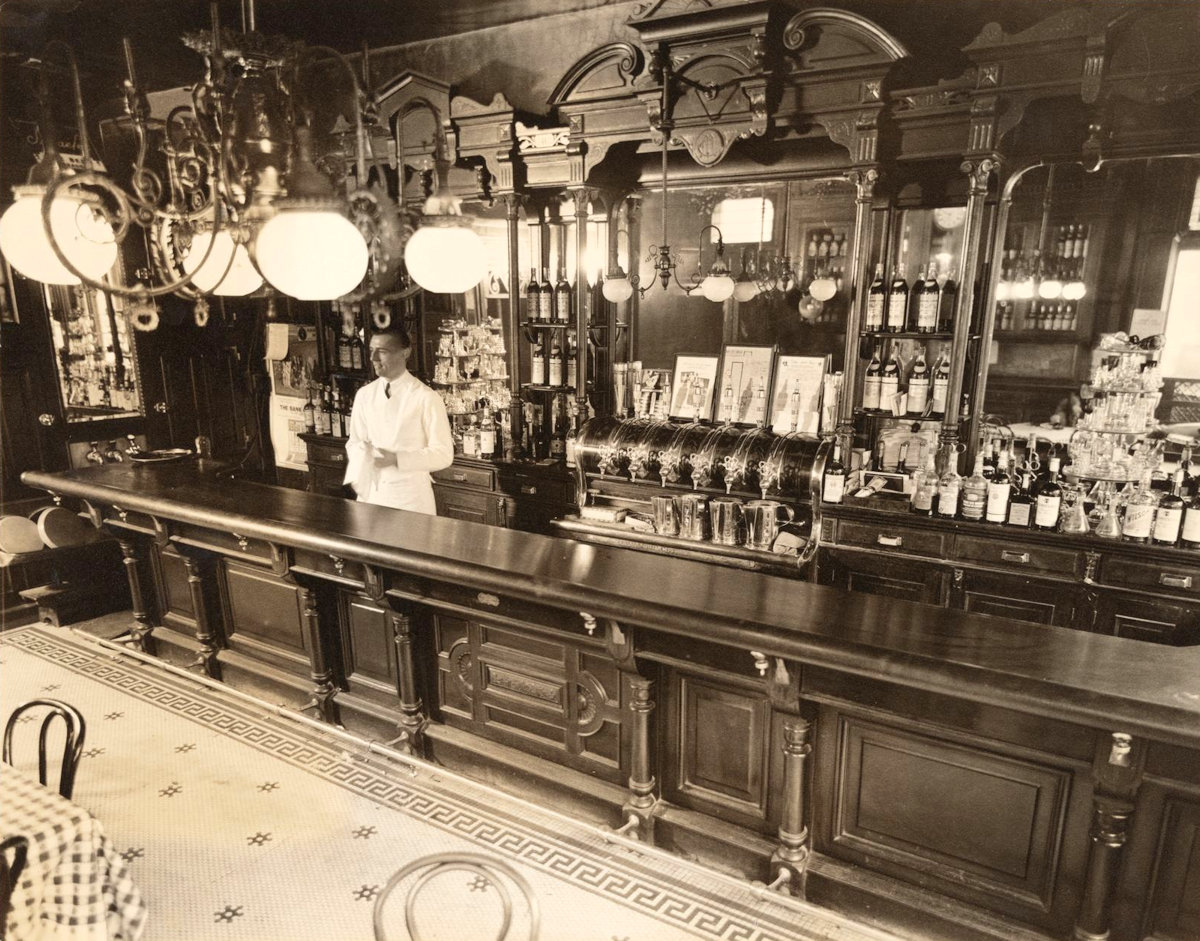
Fifth Avenue double-decker bus in Washington Square
Now that’s a bus! This classic coach has vintage vibe written all over it. Pulled up to a stop in Washington Square, the driver is ready to take on more passengers – there’s plenty of room aboard this beauty! The historic Washington Square Arch, a tribute to the nation’s first president, peeks out from behind the bus, and a little bit of art deco rises into the sky further in the distance, forming a quintessential New York City backdrop to what might be an otherwise ordinary scene.
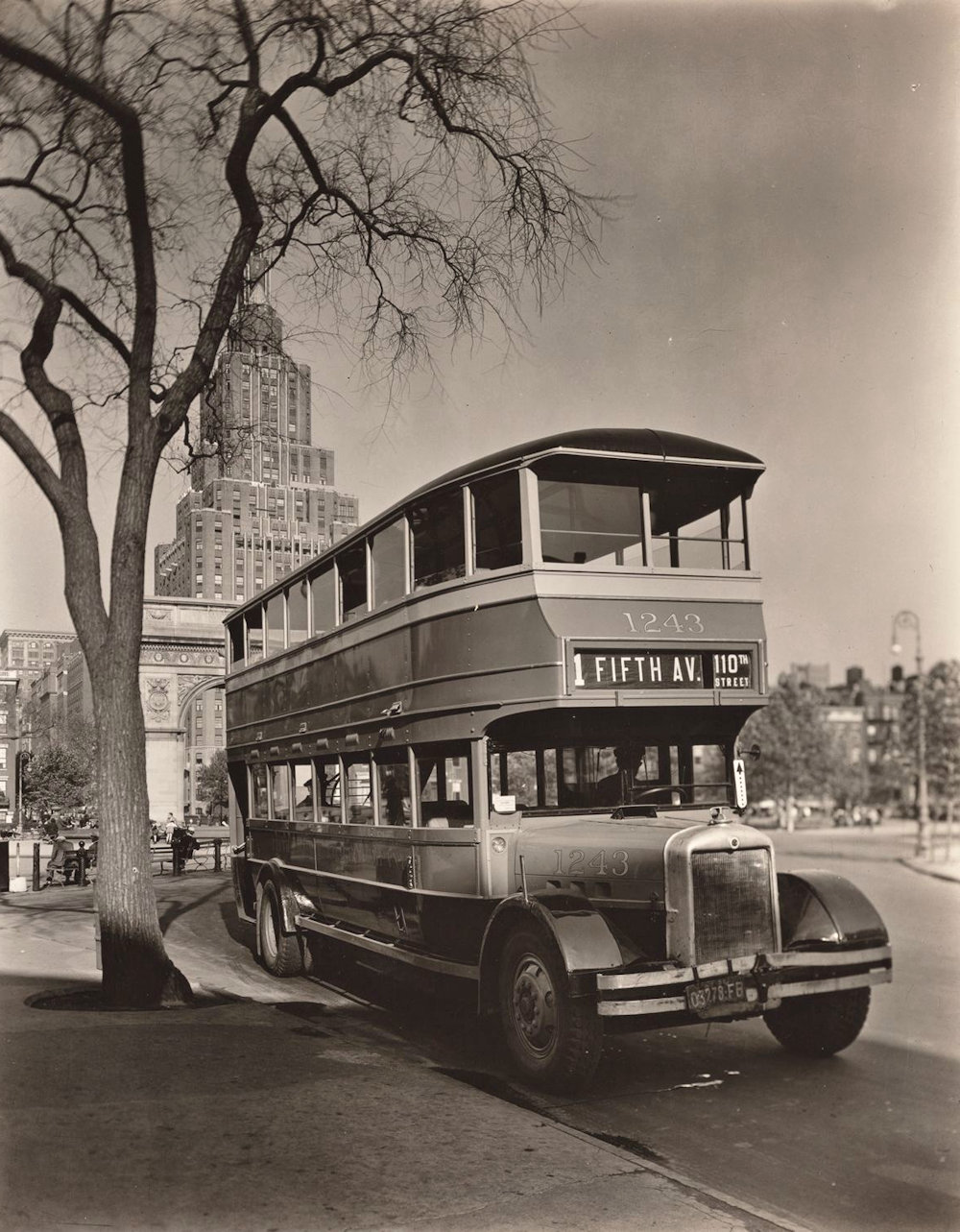
Mandaro Cheese Store on Bleecker Street
In the 1930’s, New York City was filled with just as many specialty food stores as it is today. This cheese shop at 276 Bleecker Street was most likely a family affair, where great care was taken in displaying one’s wares. The variety of cheeses in this window would no doubt draw in many a passers-by, and the shop probably had a regular clientele as well. I mean, honestly – who doesn’t love fresh cheese?

Rothman’s Pawn Shop on Eighth Avenue
Need a little loan to tide you over till payday? Give Rothman’s a call! This full service pawn shop in the Chelsea neighborhood of Manhattan offered loans on everything from sporting goods and luggage, to clothing and jewelry. Wanna store your furs away for the summer? They’ll give you a loan for those, too! Today’s Las Vegas may have the Harrison men of “Pawn Stars”, but in the 1930’s in New York City, Rothman’s was the place to go.
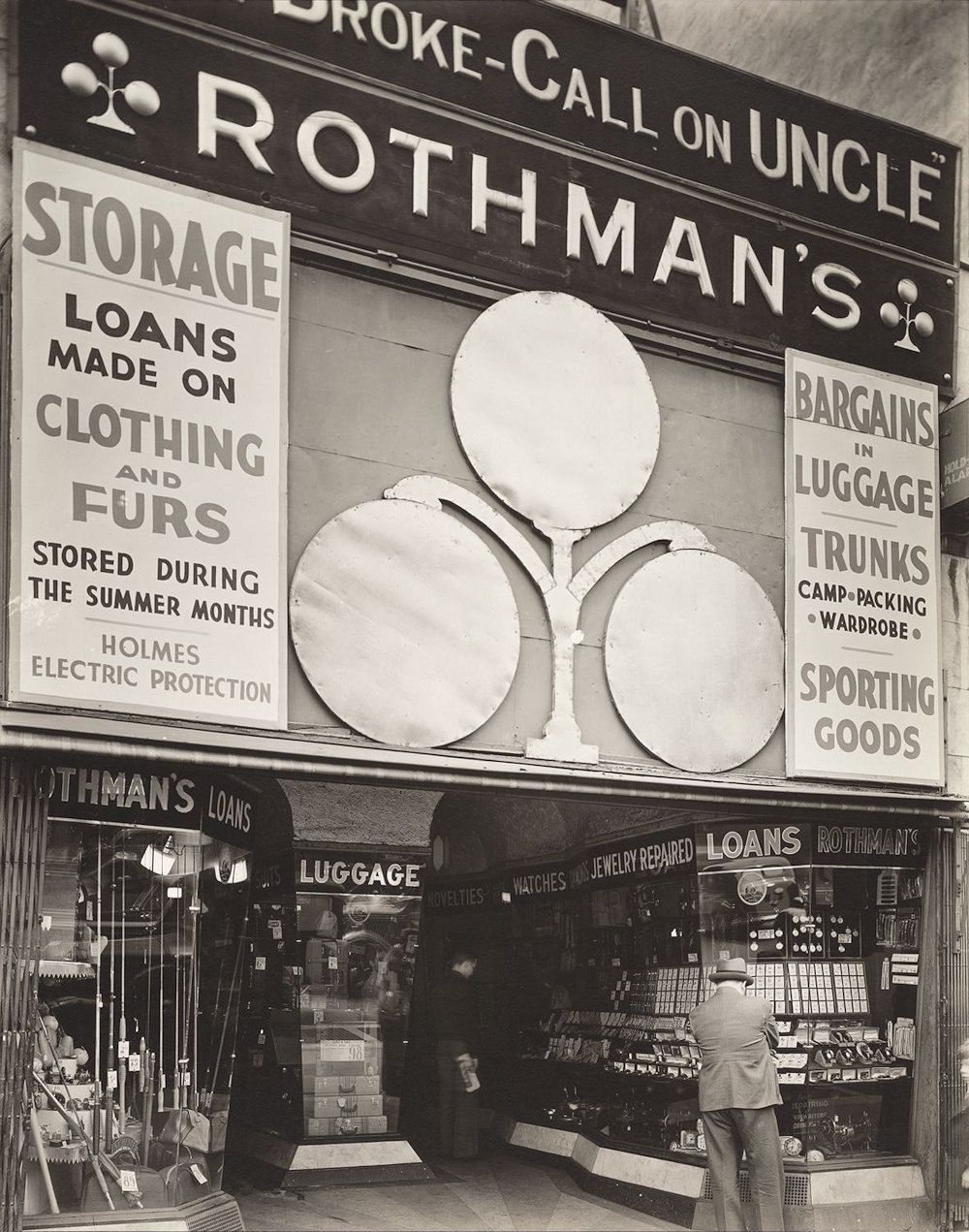
Stern Brothers Service Station on West Street
In yet another installment in the “Changing New York” collection, this fantastic vintage photo by Berenice Abbott features a family-owned service station on West Street set against a backdrop of New York City skyscrapers. The architecture is stunning, the signage is crisp, the cars are to die for – if you’re into cars, that is. Everything about this photo screams New York, and even if you’ve never been to the Big Apple, one look at this image – as well as many others in this group – will leave no doubt in your mind that that’s exactly where you are.

New York’s East 48th Street against a skyscraper backdrop
There are so many things to love about this photo, it’s hard to know where to begin. From the vintage automobiles to the elevated train tracks, the printing shop and laundry to the fire escapes. And don’t forget the Art Deco skyscrapers, including the distinctive Waldorf Astoria in the distance. Taken in 1938, it’s a view from East 48th Street, looking northwest from a point between 2nd and 3rd Avenues.
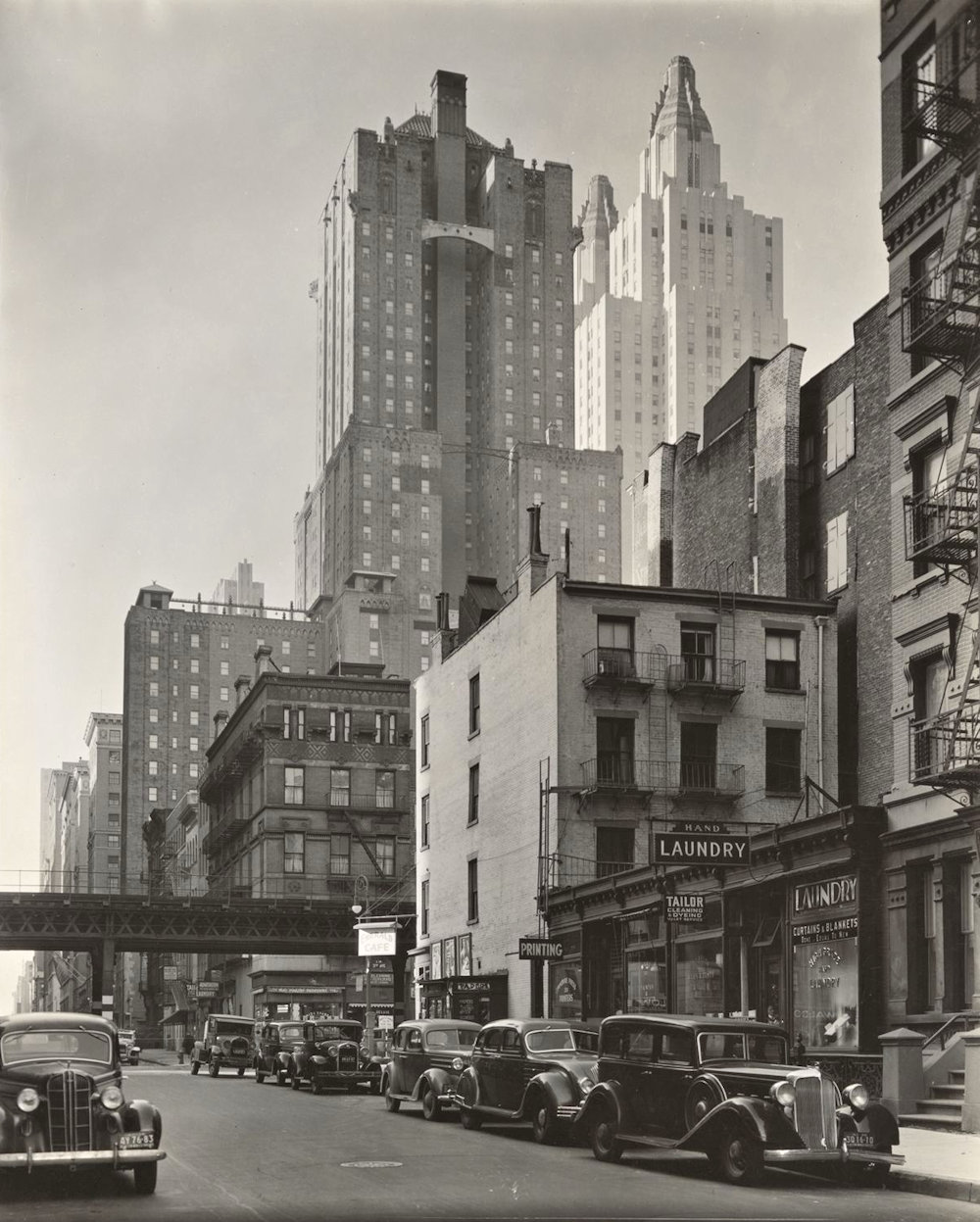
St. Mark’s Place on Staten Island, 1937
There are very few places in this world left untouched by the passage of time, but unfortunately this neighborhood at the north end of Staten Island, in an area called Brighton Heights, is not one of them. The big beautiful and unique homes on this particular street, pictured here in 1937, have now been replaced with office buildings. The only thing left is the Brighton Heights Reformed Church, but sadly it’s not the same building pictured in the photo. A fire destroyed the church in 1996, but was rebuilt and reopened in 1999 in the same location, but with an updated look.

McSorley’s Ale House in the East Village
In the East Village neighborhood of Manhattan Island, there’s an old Irish pub called McSorley’s, built originally in 1854 and pictured here in 1937. Step right up to the bar to get yourself a beer, and possibly a sandwich for just 10-15 cents. Out of smokes? No problem, there’s a cigarette machine in the corner at right. All the men pictured here, most dressed in suits and wearing fedoras, seem to have stopped in for a little refreshment after a long day at work. Like many pubs around the city, McSorley’s is a gathering place, where friends come to pass the time and enjoy one another’s company.
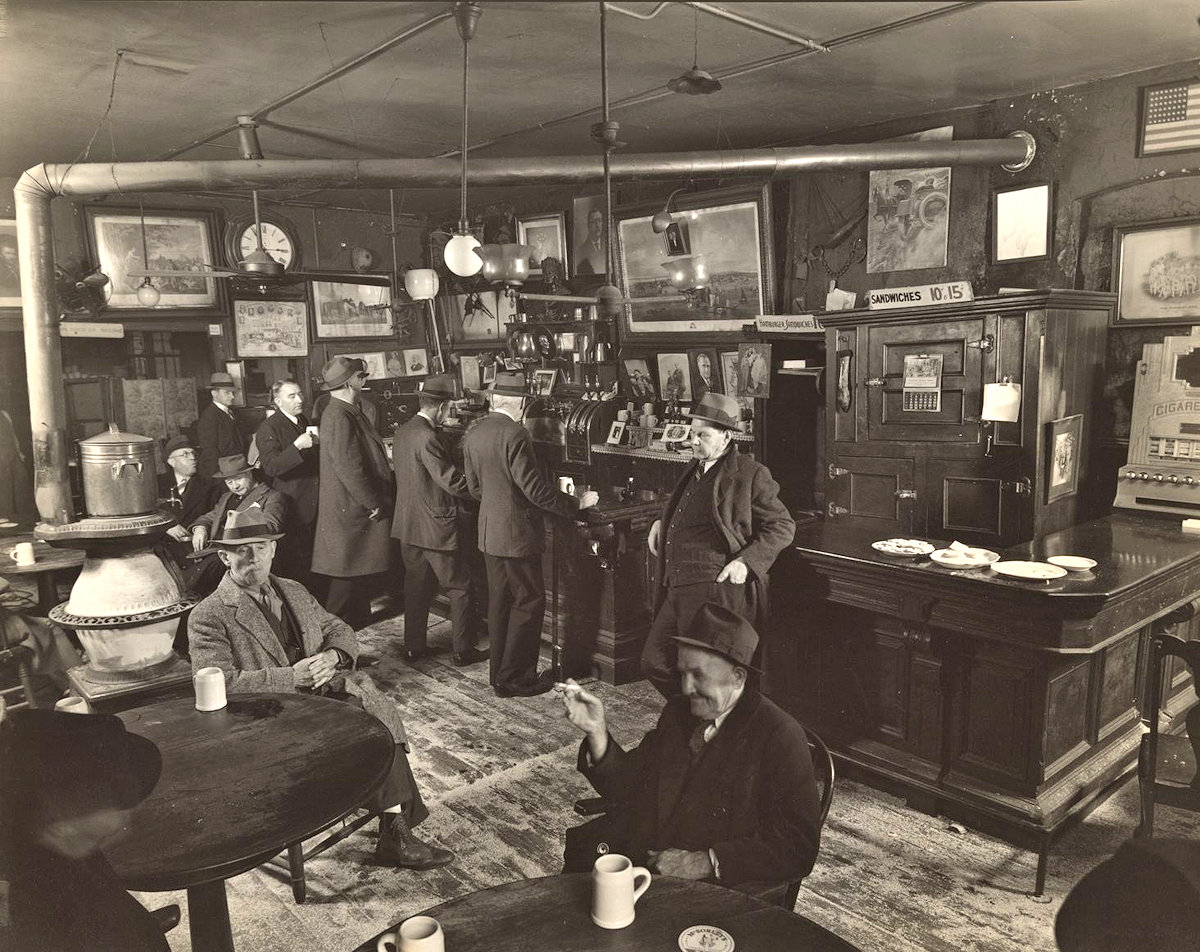
William Goldberg Clothing Store on Broadway
Yet another entry in Berenice Abbott’s “Changing New York” collection, this photo of the William Goldberg clothing store on Broadway makes it clear that the owner wanted to take full advantage of having such a prominent street corner location, using big bold signage to lure passers-by into his store. If Ms. Abbott were to visit this location today, she would be surprised to find that New York had changed yet again. The building is now home to not a clothing store, but a coffee house – at least on the ground level.
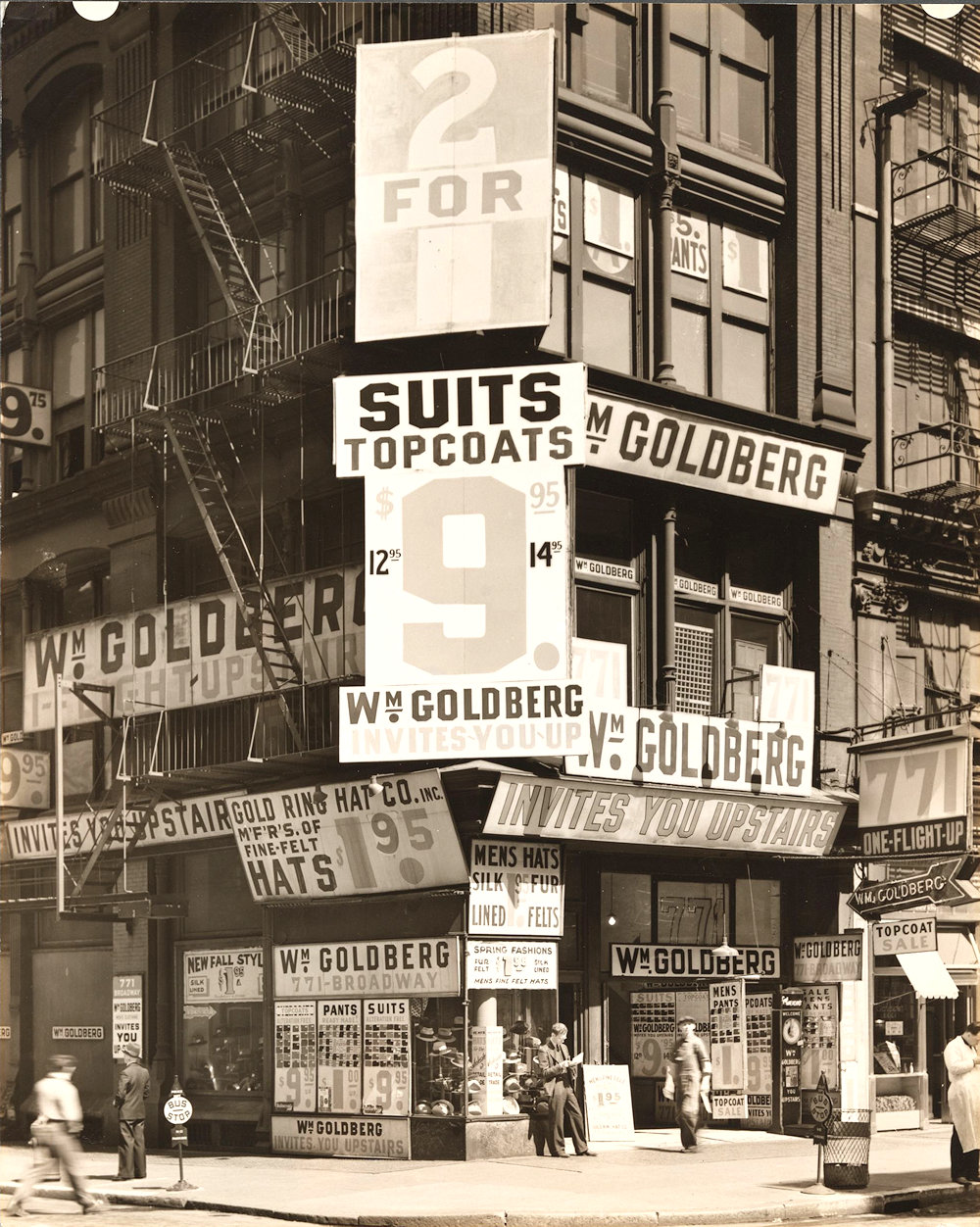
Manhattan side of Triborough Bridge
What is now officially known as the Robert F. Kennedy Bridge was built in the 1930’s and known then as the Triborough Bridge (and many still refer to it as that today). The bridge connects the three boroughs of Manhattan, Queens, and the Bronx, passing over Randall’s Island on its way to each. This photo shows the East 125th Street approach from East Harlem in Manhattan, which is itself a lift bridge over the Harlem River. The photo was taken in 1937, just a year after the bridge first opened.
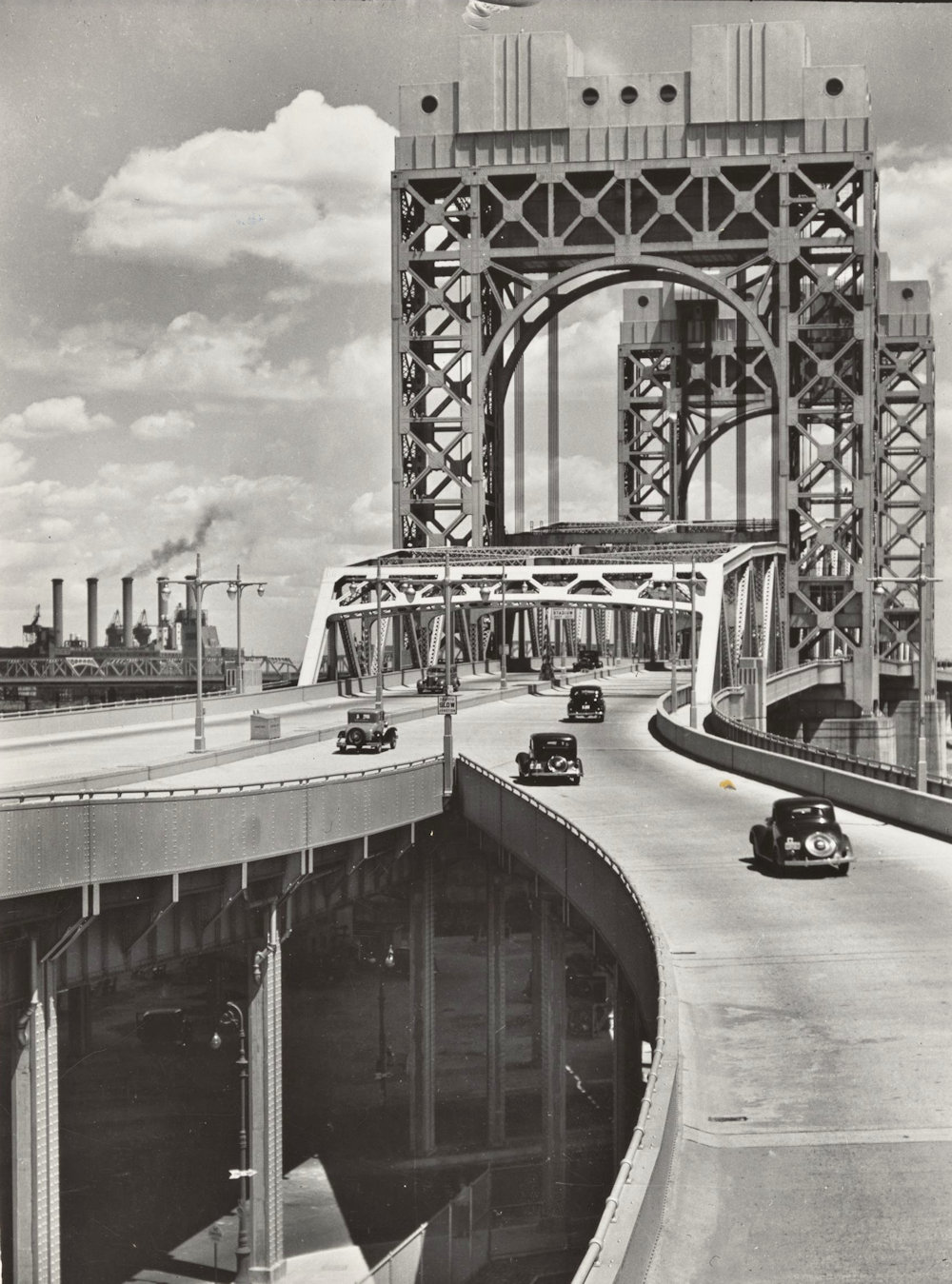
Pennsylvania Railroad building at Pier 21 near Brooklyn Bridge
This 1937 photo by Berenice Abbott shows the pier shed of the Pennsylvania Railroad at Pier 21 on South Street in Manhattan, with the Brooklyn Bridge above and the Manhattan Bridge in the distance. Trucks are loading and unloading along the pier on what appears to be a busy workday. Like many other places around the city, however, the waterfront has changed over the years, and the pier shed was leveled to make way for FDR Drive which follows all along the east side of the island.
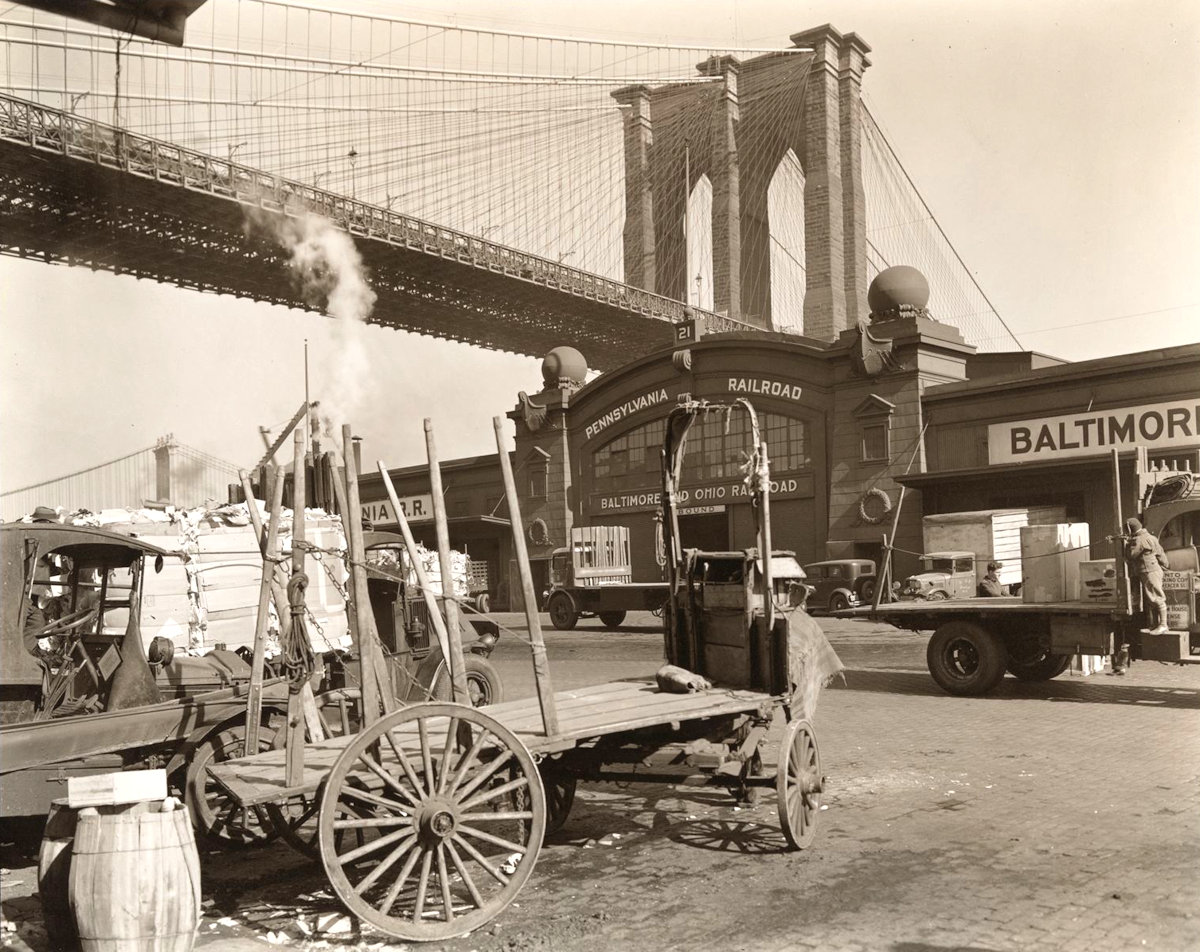
Irving Place Theatre in Manhattan
The Irving Place Theatre, pictured here in 1938, was located in the Union Square neighborhood of Manhattan, on the southwest corner of Irving Place and East 15th Street. Originally opened in 1888, it served many functions over the years, including a German language theatre, a Yiddish theatre, a burlesque house, a union meeting hall, a legitimate theatre and a movie theatre. Unfortunately, the theatre and building were demolished in 1984, replaced now by an office building.

Neighborhood businesses on a Harlem street
New York City has always been a town filled with neighborhood storefronts, and this street in Harlem is no exception. Businesses at street level in this neighborhood include a beauty salon, barber shop, photo studio, driving school, and grocery store – all very convenient for the residents who live in the apartments up above! Today, the building facade has been completely renovated and has none of the charm of the old architecture featured in this photo and others taken by Berenice Abbott almost a century ago.
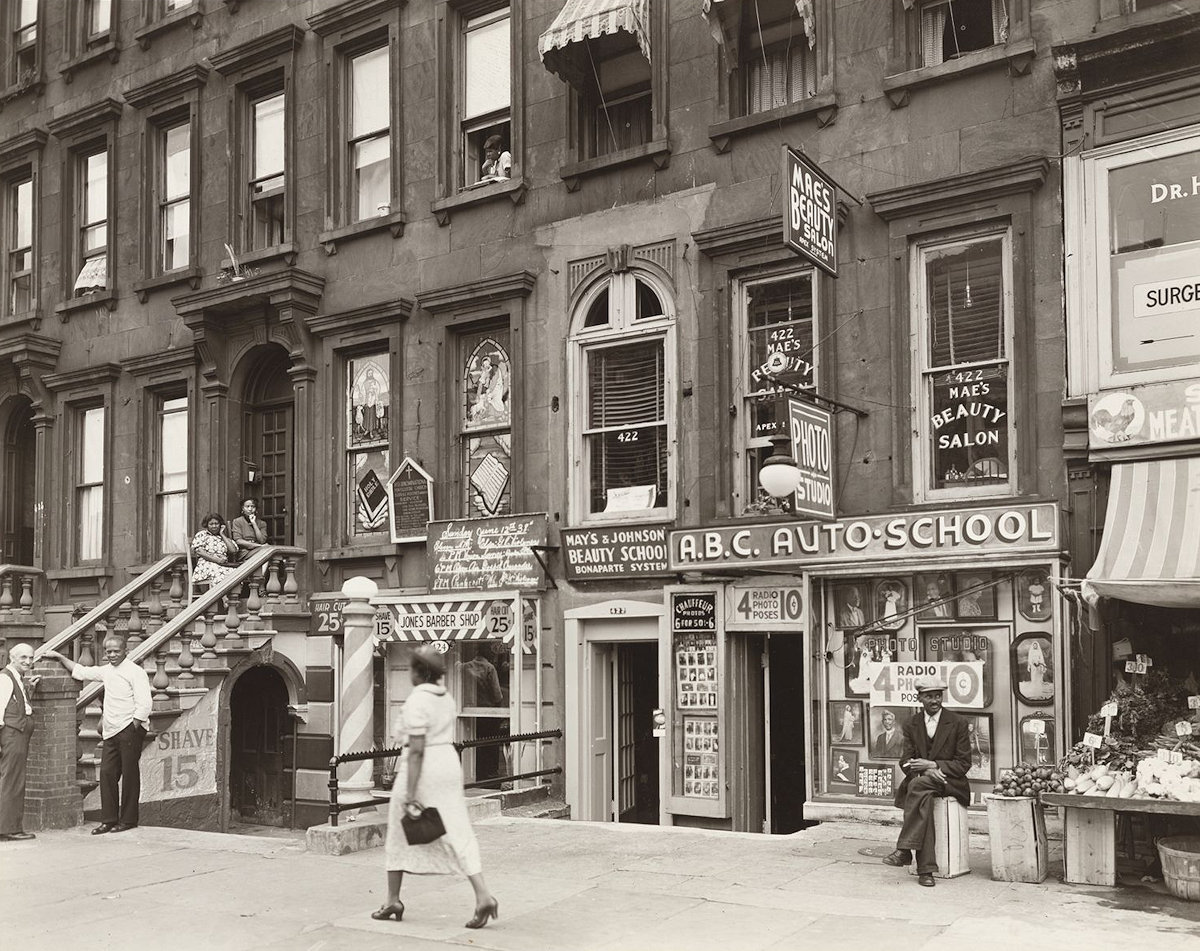
Luchow’s Restaurant and City Theatre in East Village
Dinner and a movie is a definite possibility in this 1938 scene captured by photographer Berenice Abbott. On East 14th Street, just two blocks from Union Square, one could enjoy authentic German cuisine at Luchow’s Restaurant, then catch a film at City Theatre next door. Sadly, though, as often happens, both establishments eventually met their demise. The theatre closed in 1952, and Luchow’s moved out in the 1980’s. University Hall now stands in their place.
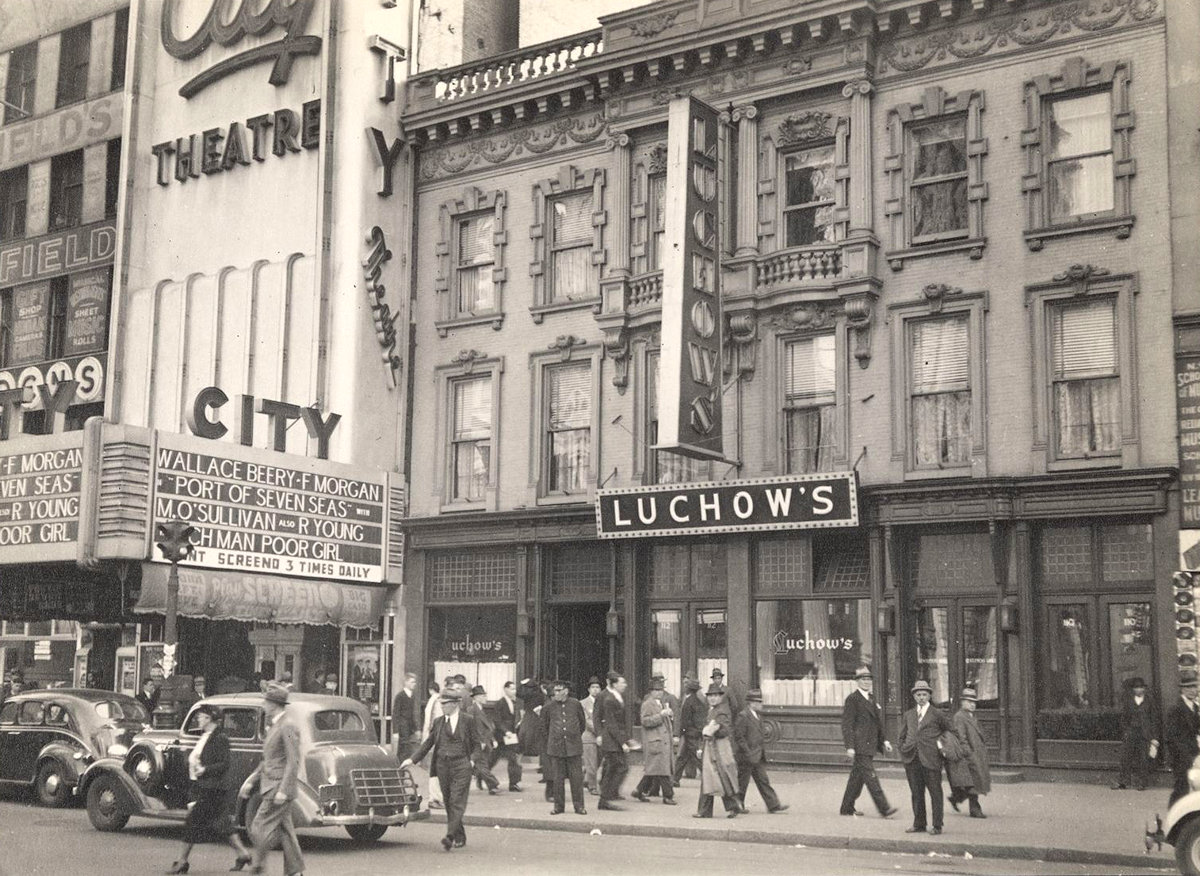
Financial District Rooftops from 60 Wall Tower
This 1938 aerial view of the rooftops of skyscrapers in New York City’s Financial District was taken by Berenice Abbott from the roof of 60 Wall Tower, a 67-story office building (now converted to residential) that was built in the early 1930’s. If you love Art Deco, then the Big Apple is definitely the place you want to be, as one can tell from the architecture of the city’s many skyscrapers.

Aerial Wall Street with peekaboo view of East River
Another rooftop view, this time from the Irving Trust Building (now condominium complex known as 1 Wall Street). The interesting-looking building shown at left with the pyramid shaped roof was known as the Bankers Trust Company Building (now just 14 Wall St.). In the distance is the East River, with several boats out and about. And, if you look real closely, you can make out all the little cars on the street below.

Aerial View from Irving Trust Building
This is another view from the roof of the Irving Trust building, focusing more directly on the waterfront. The image shows piers jutting out into the East River, framed on either side by massive skyscrapers. Again, the miniscule size of the cars when looking at them from this height makes one appreciate how much these architectural wonders tower over the city below.
